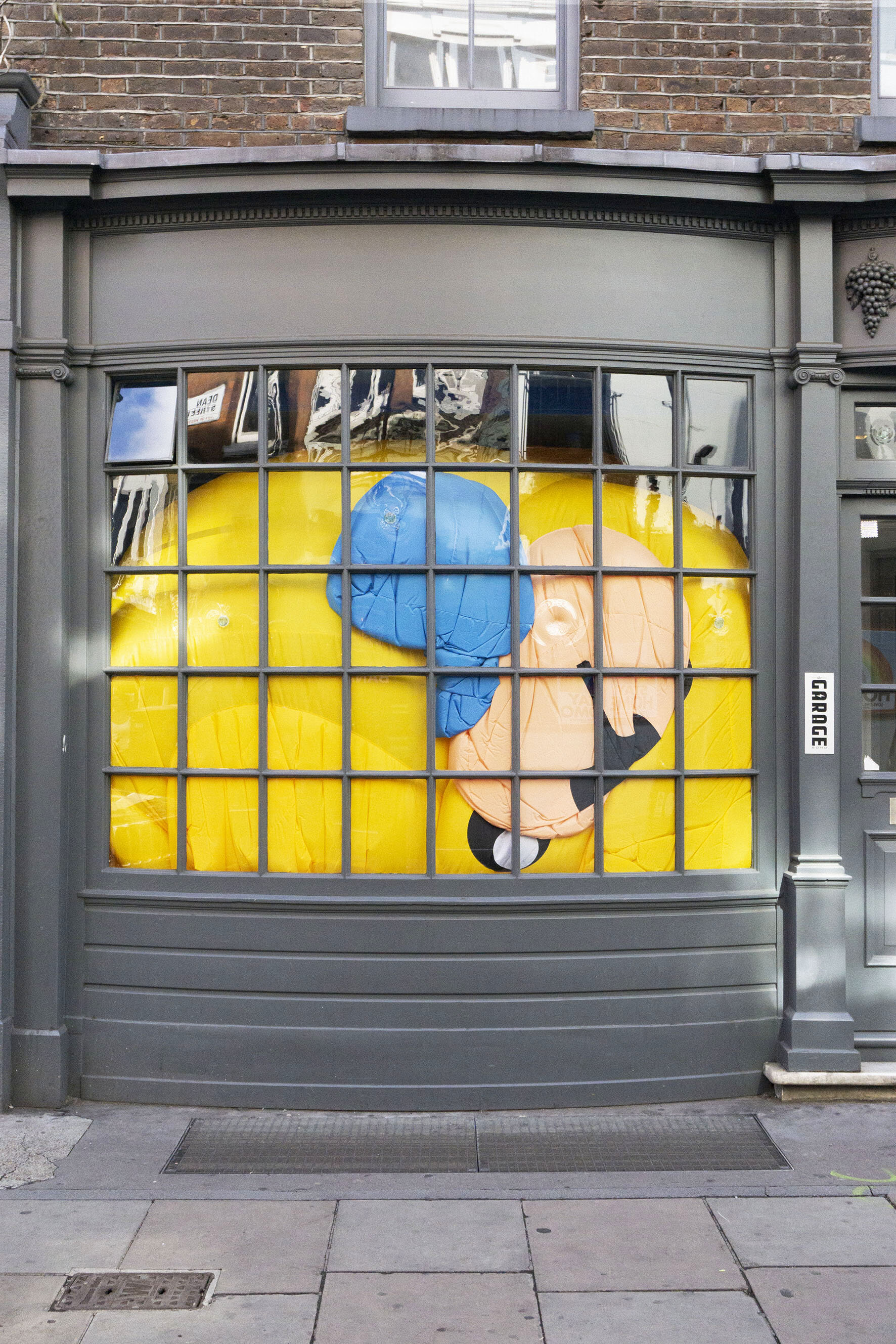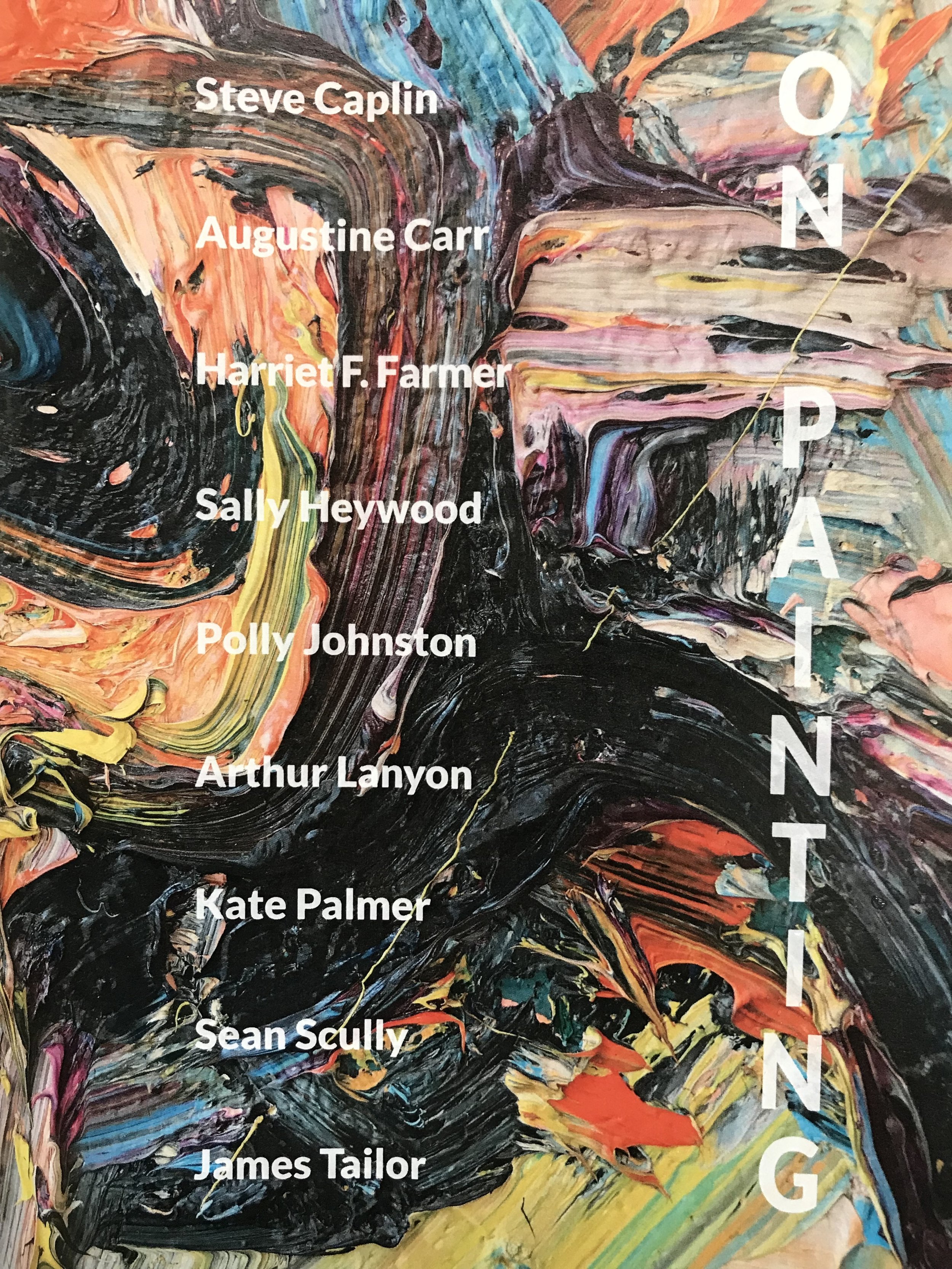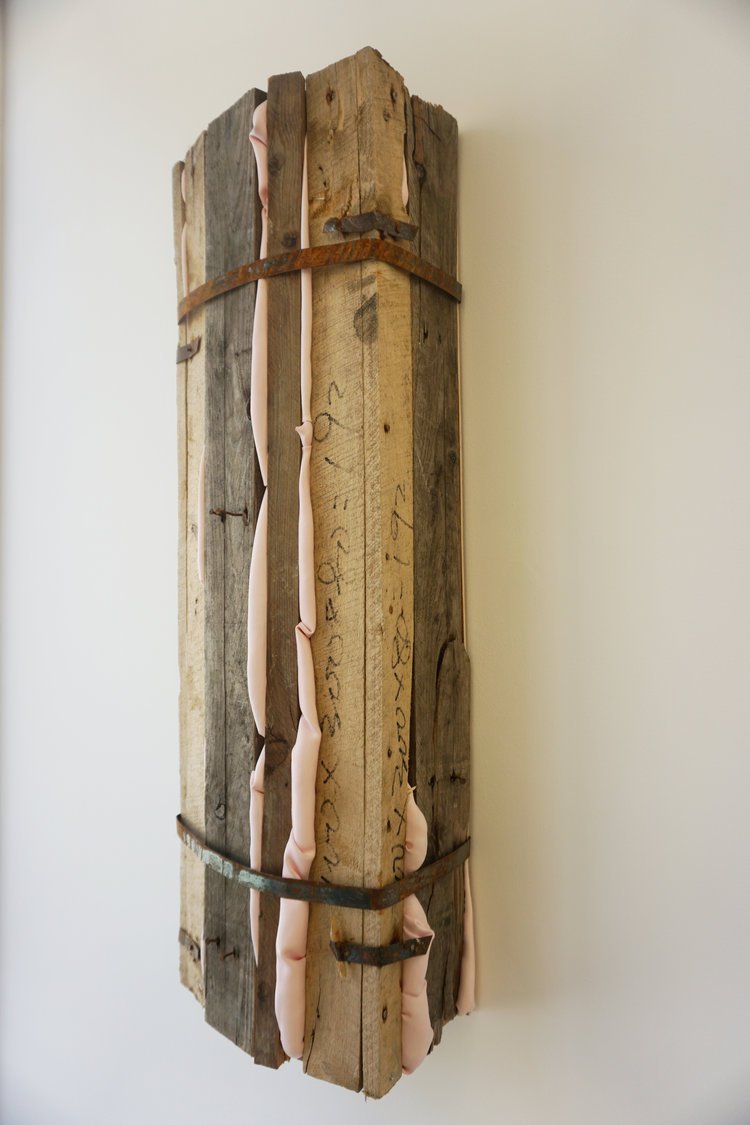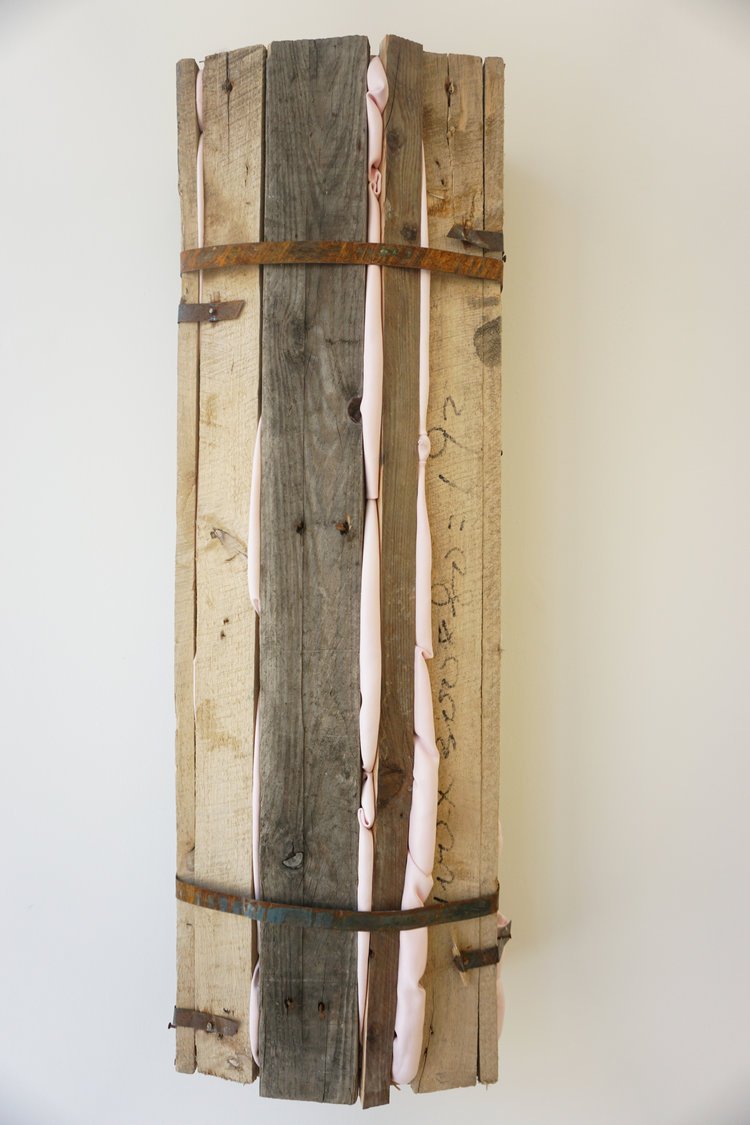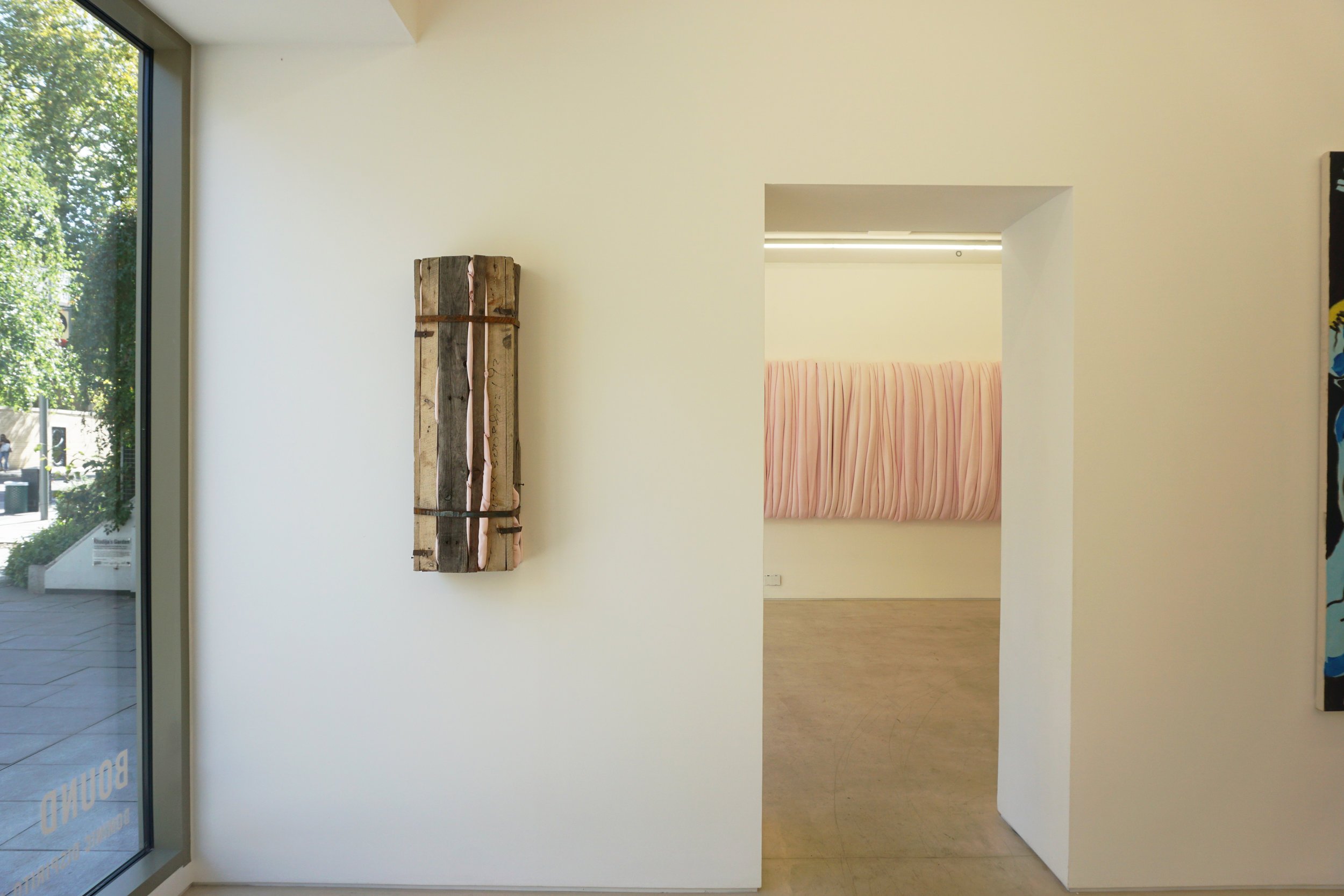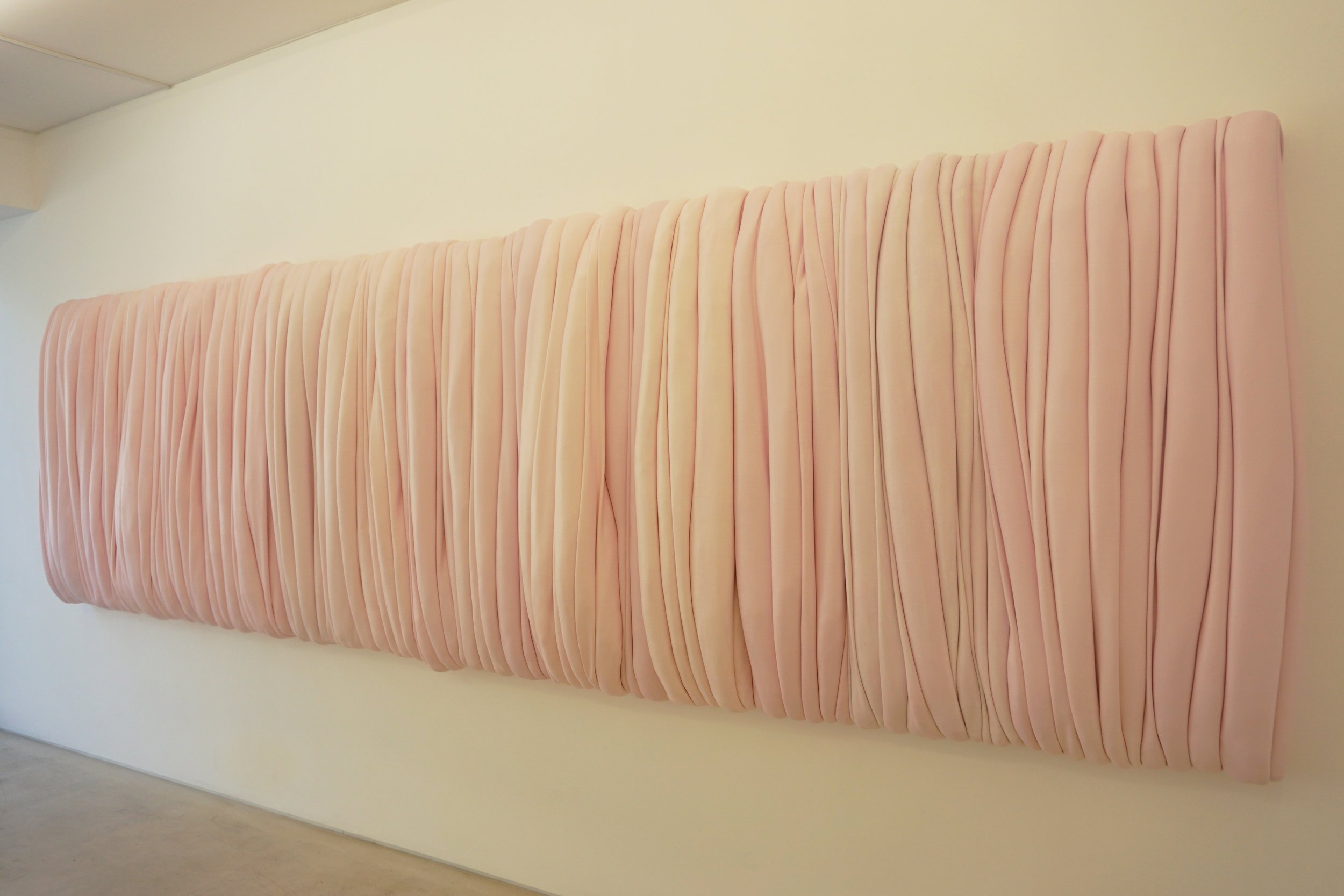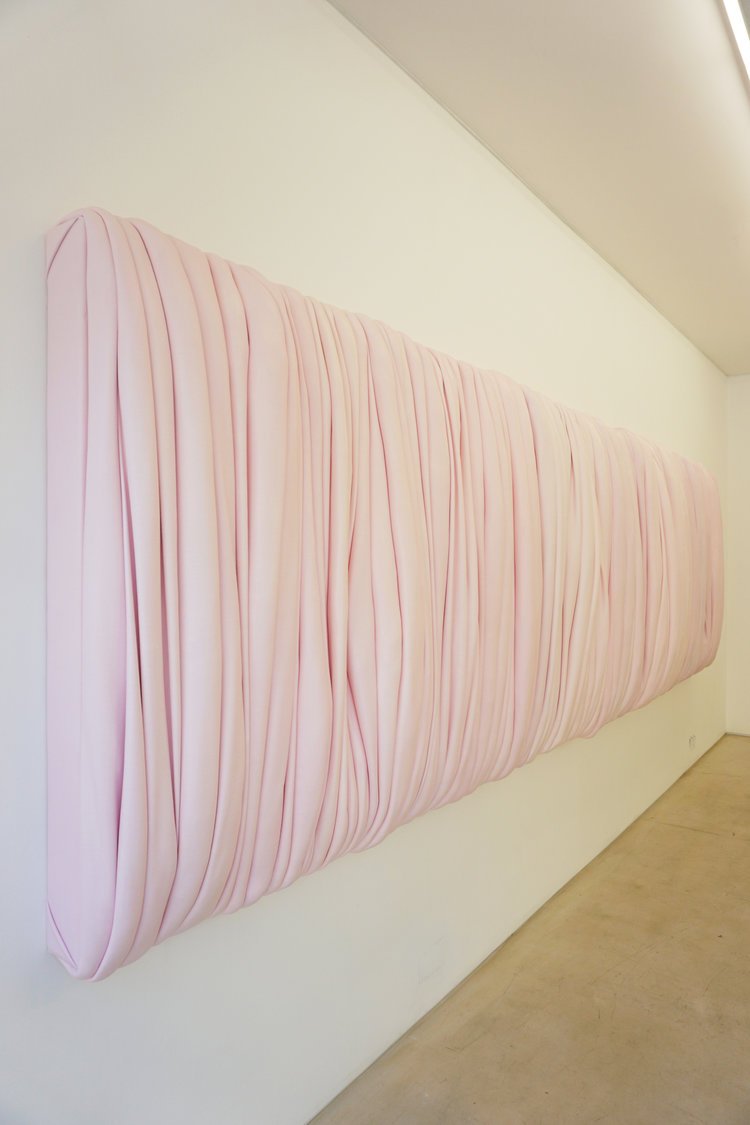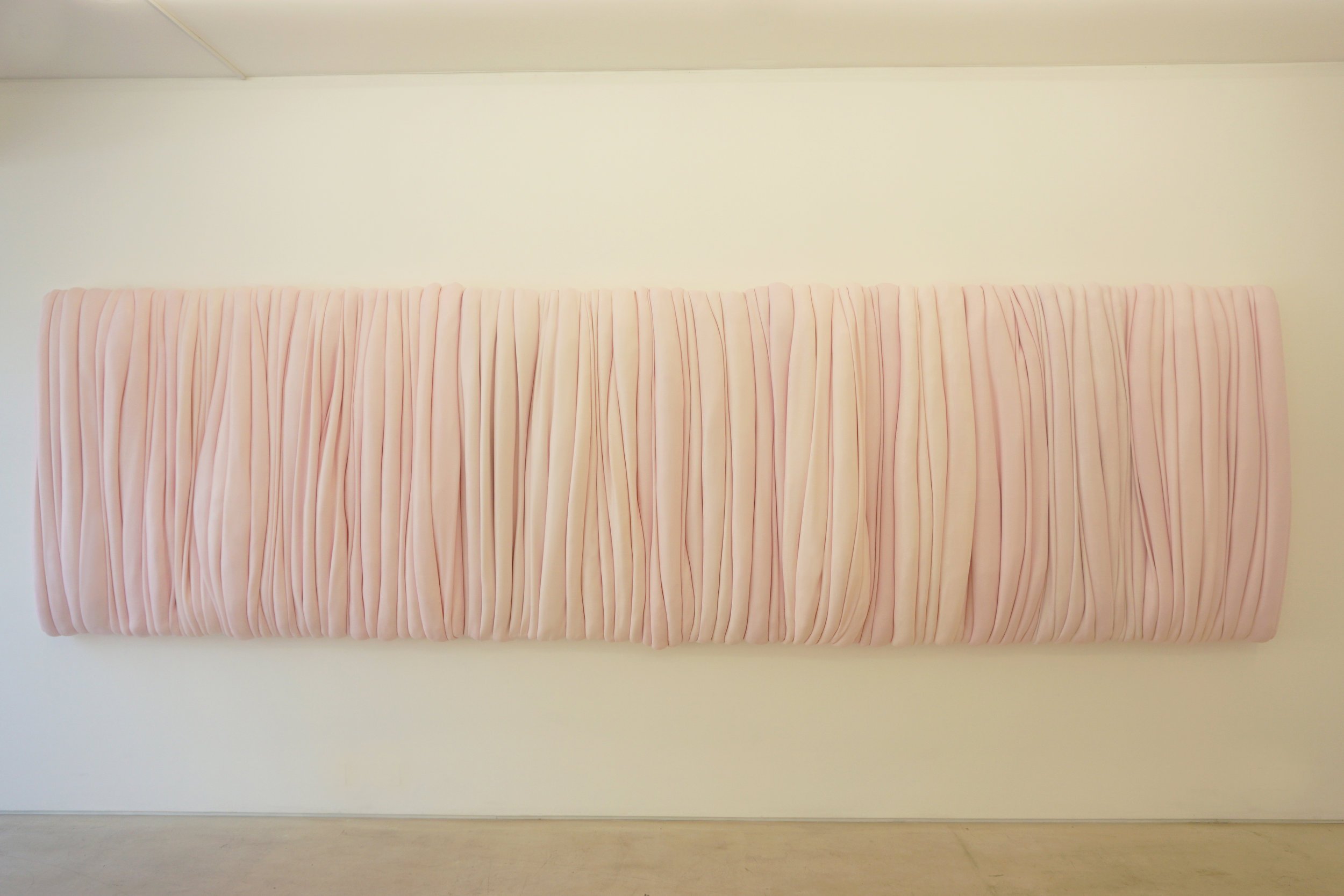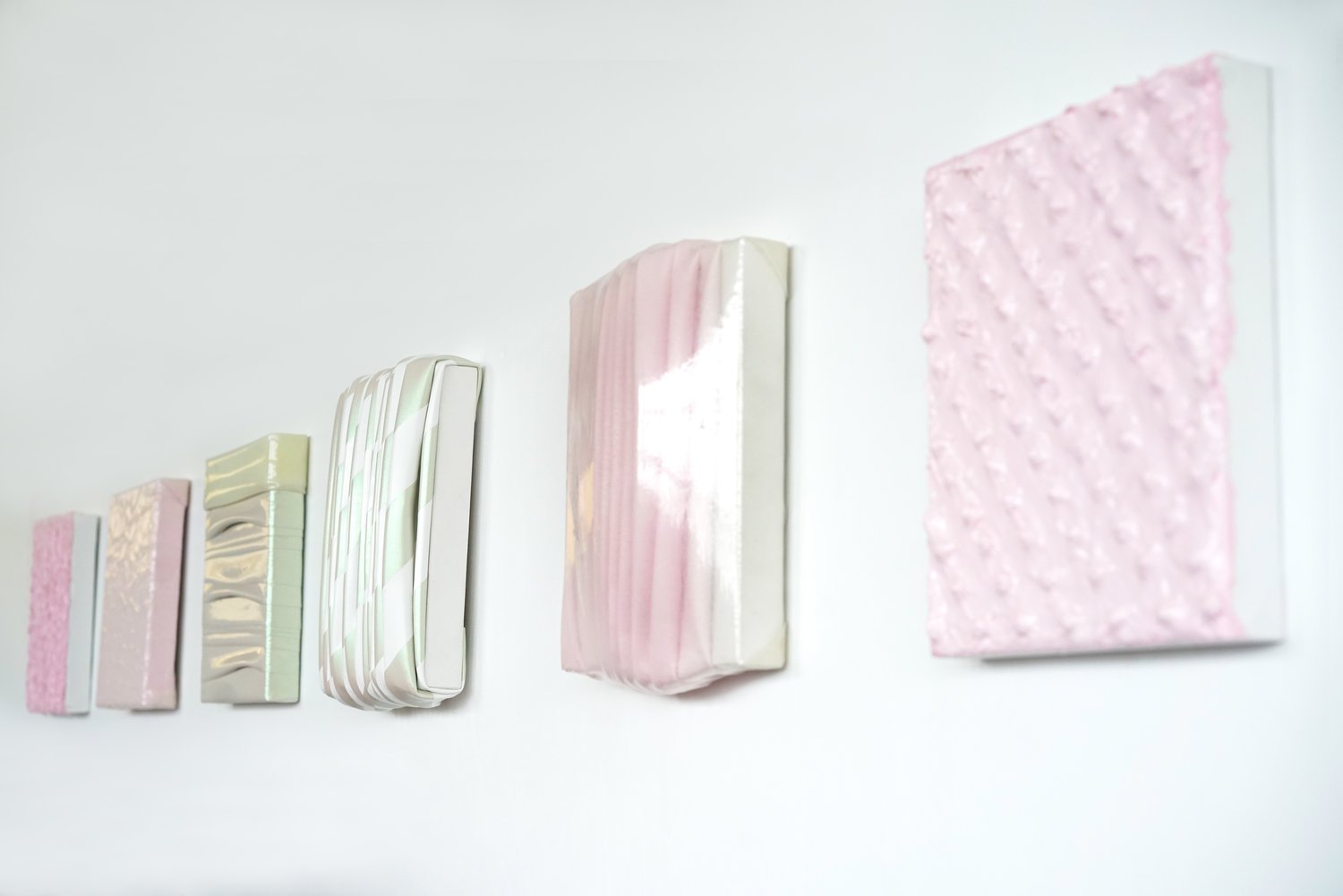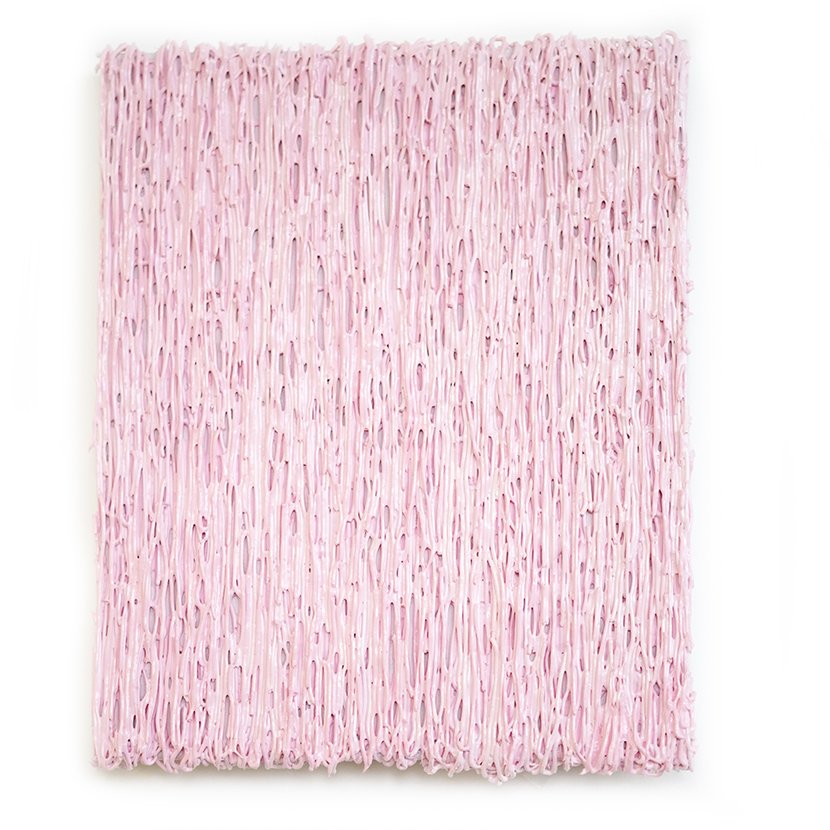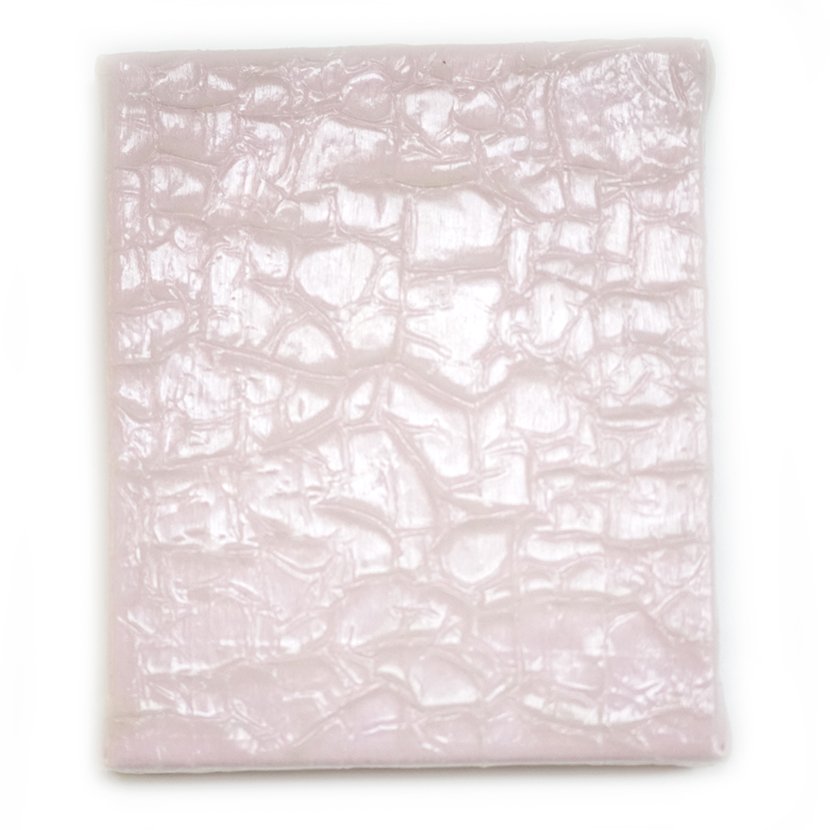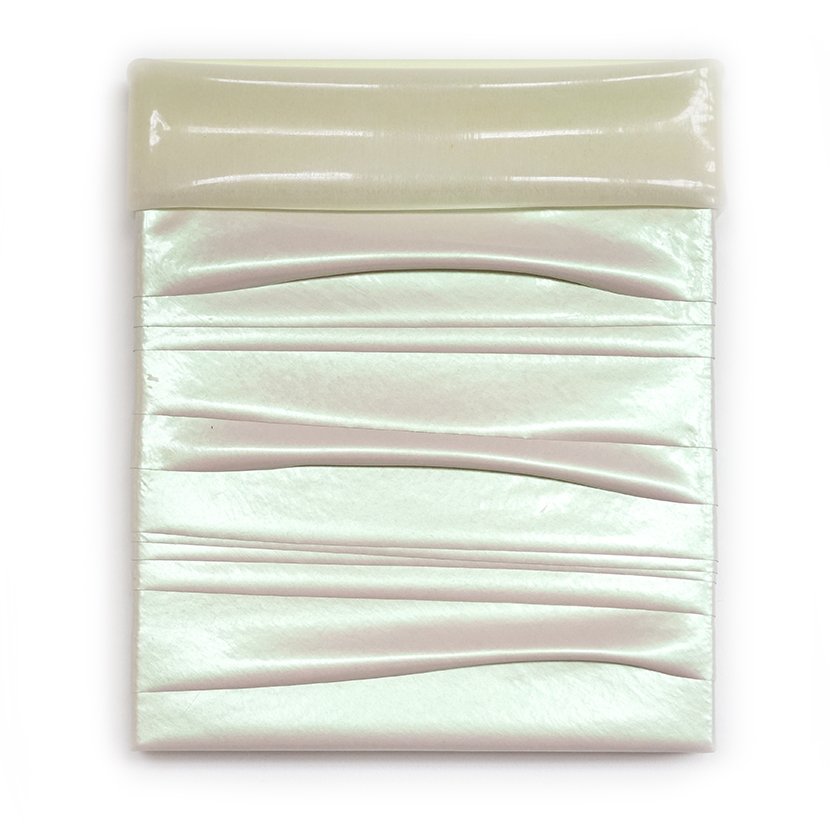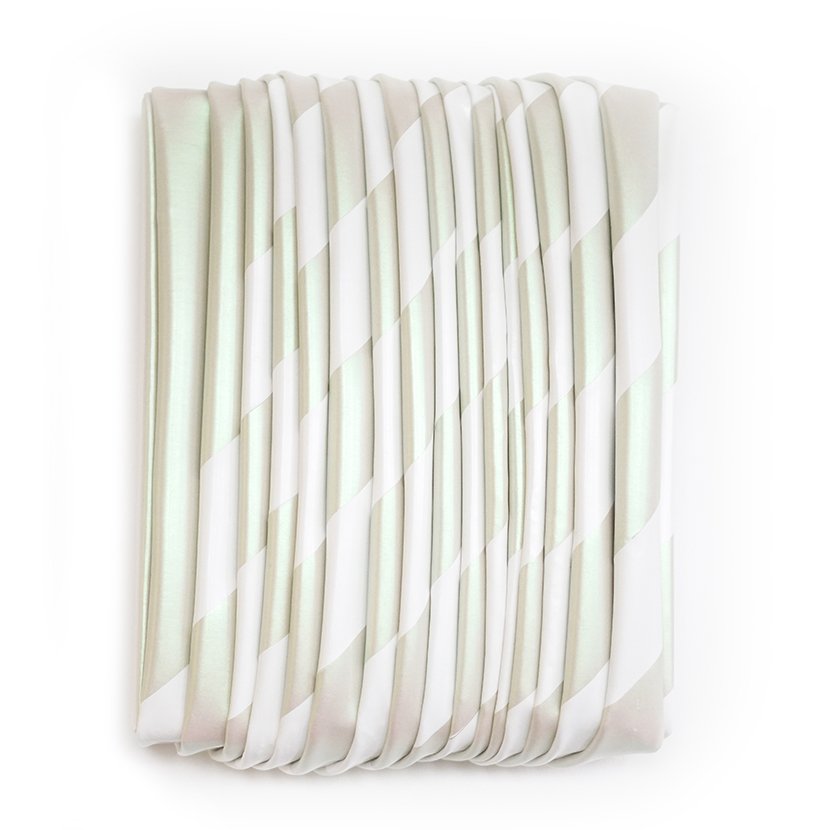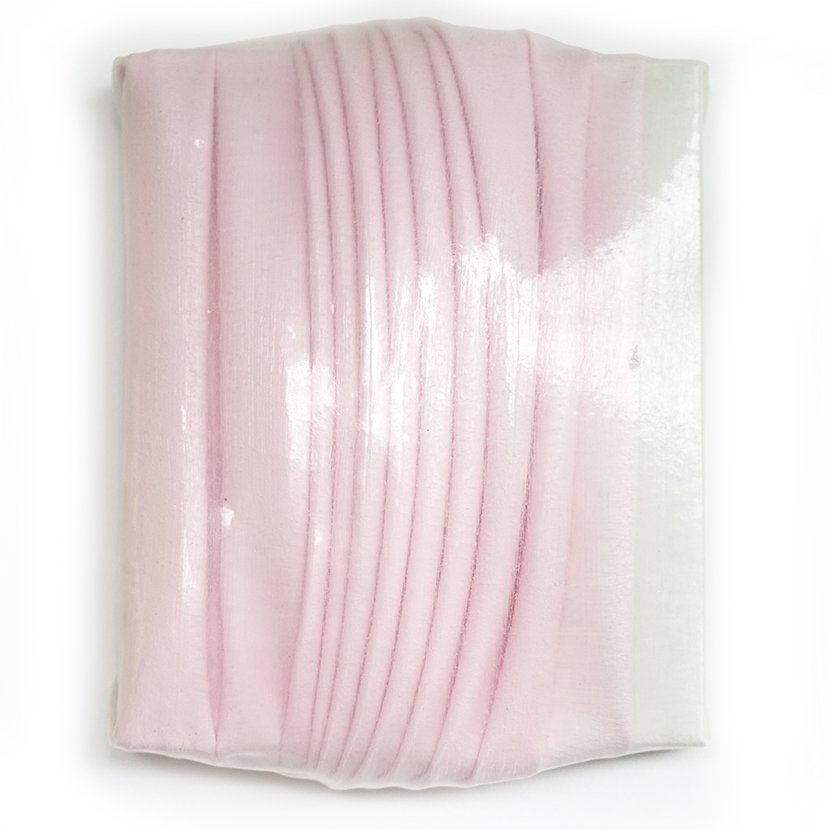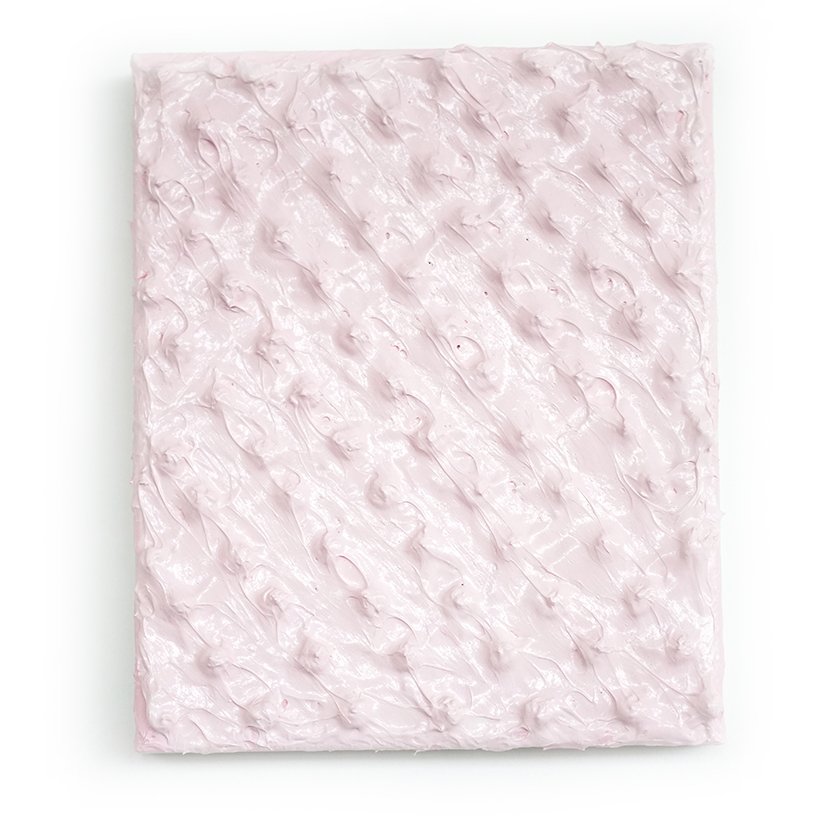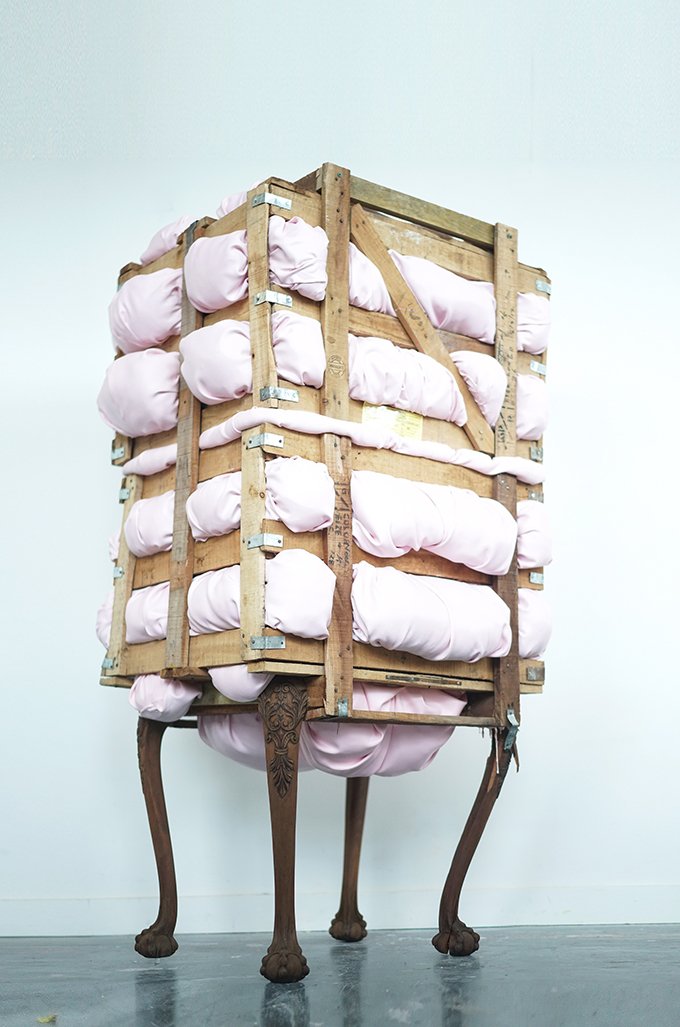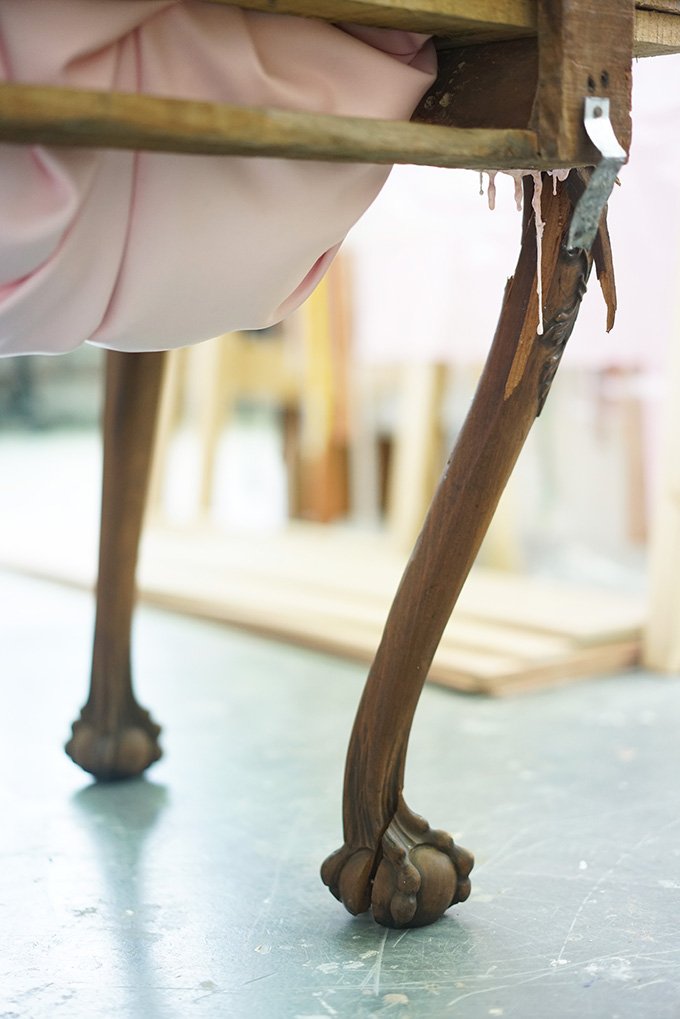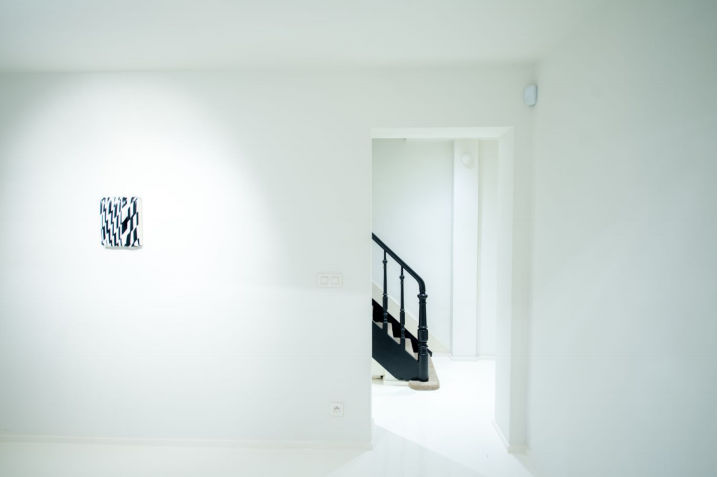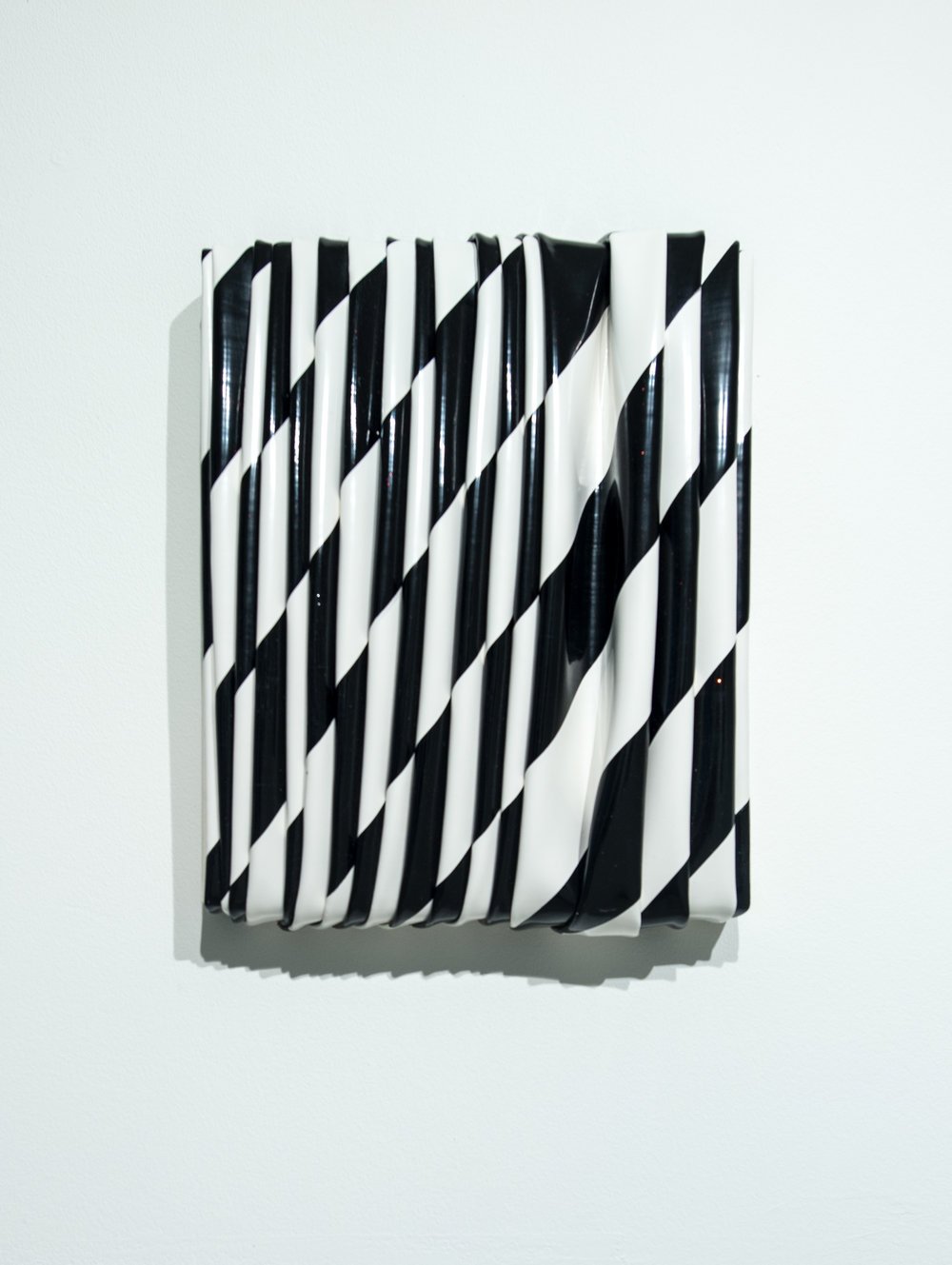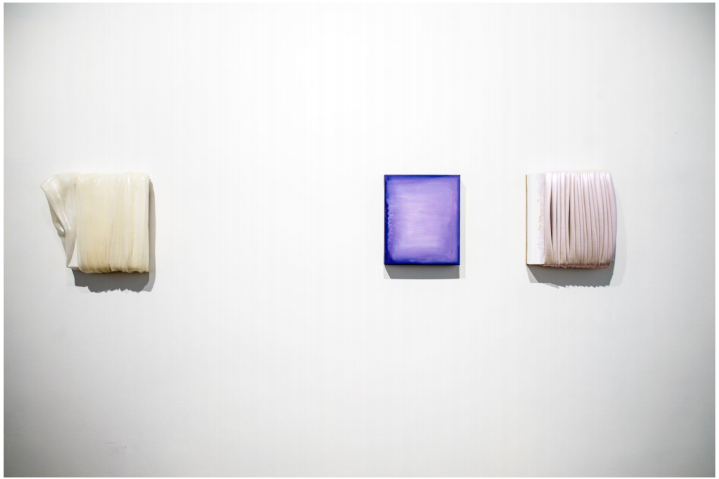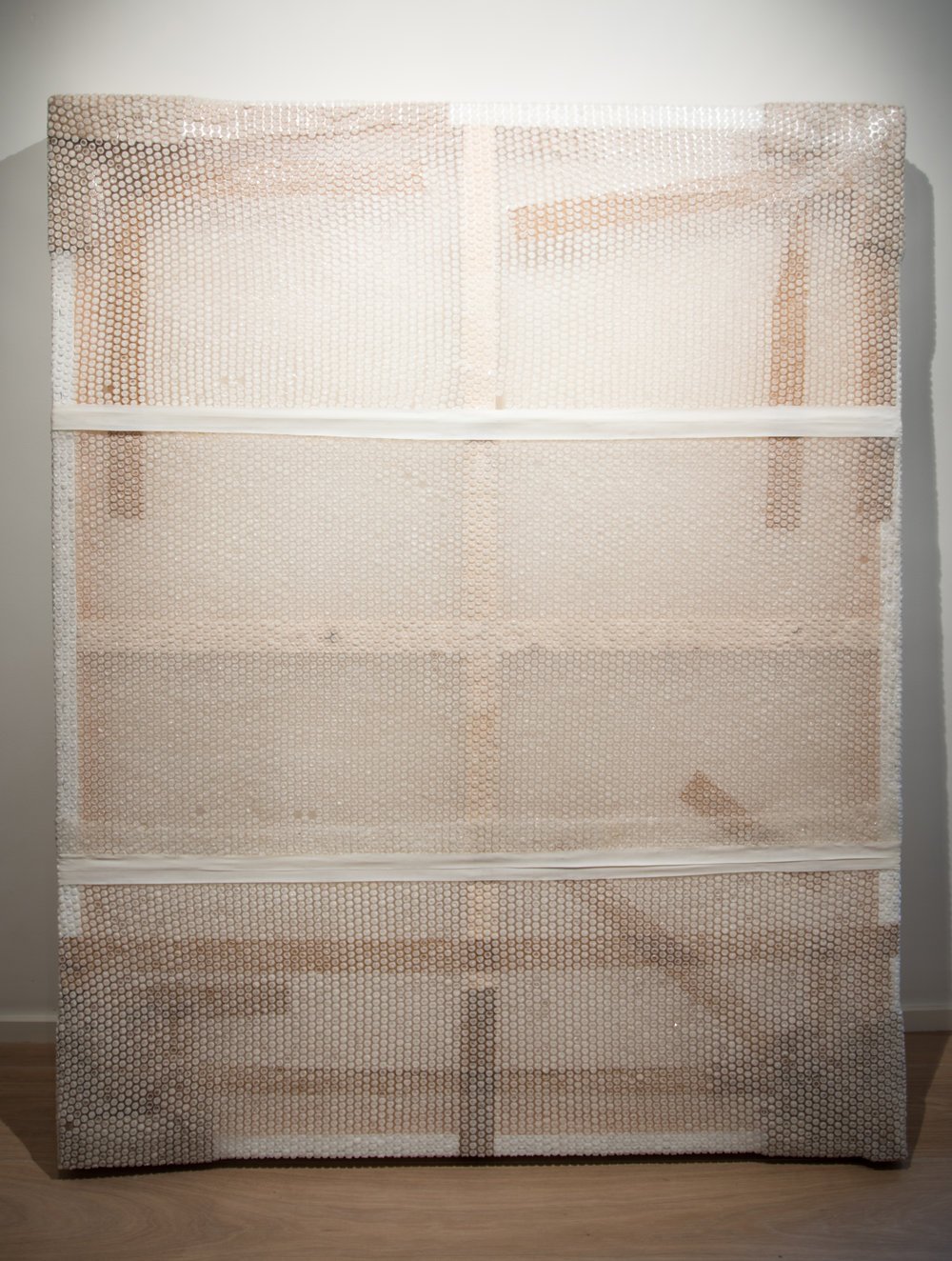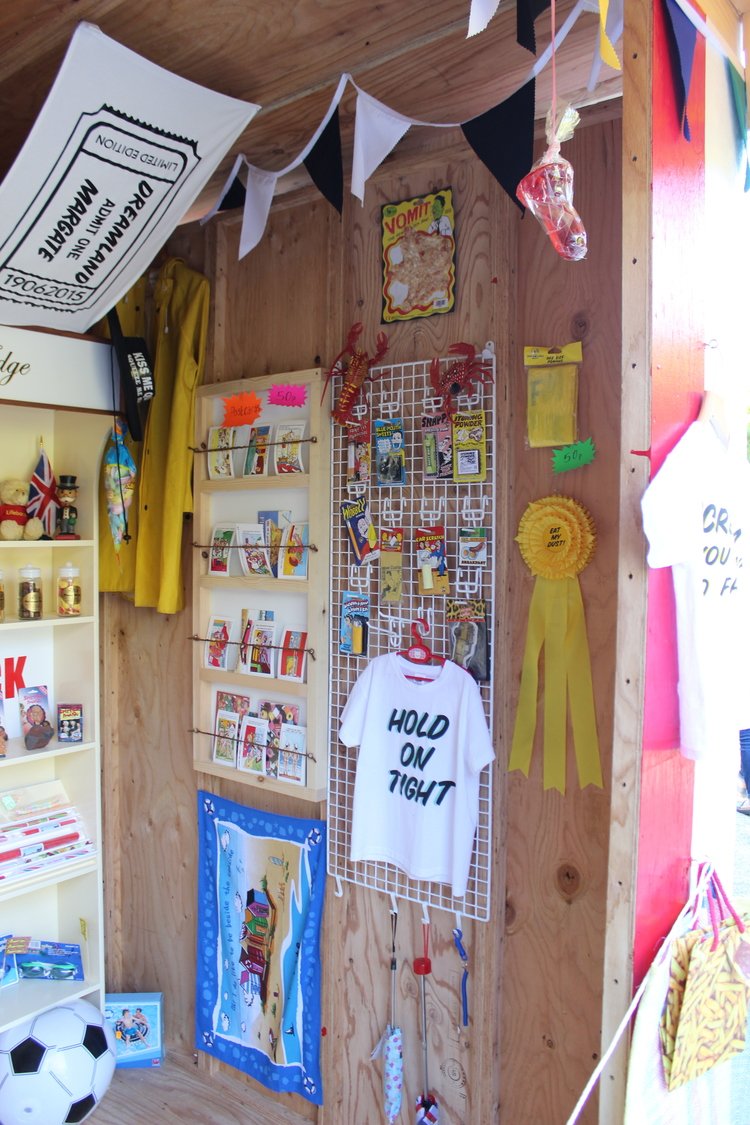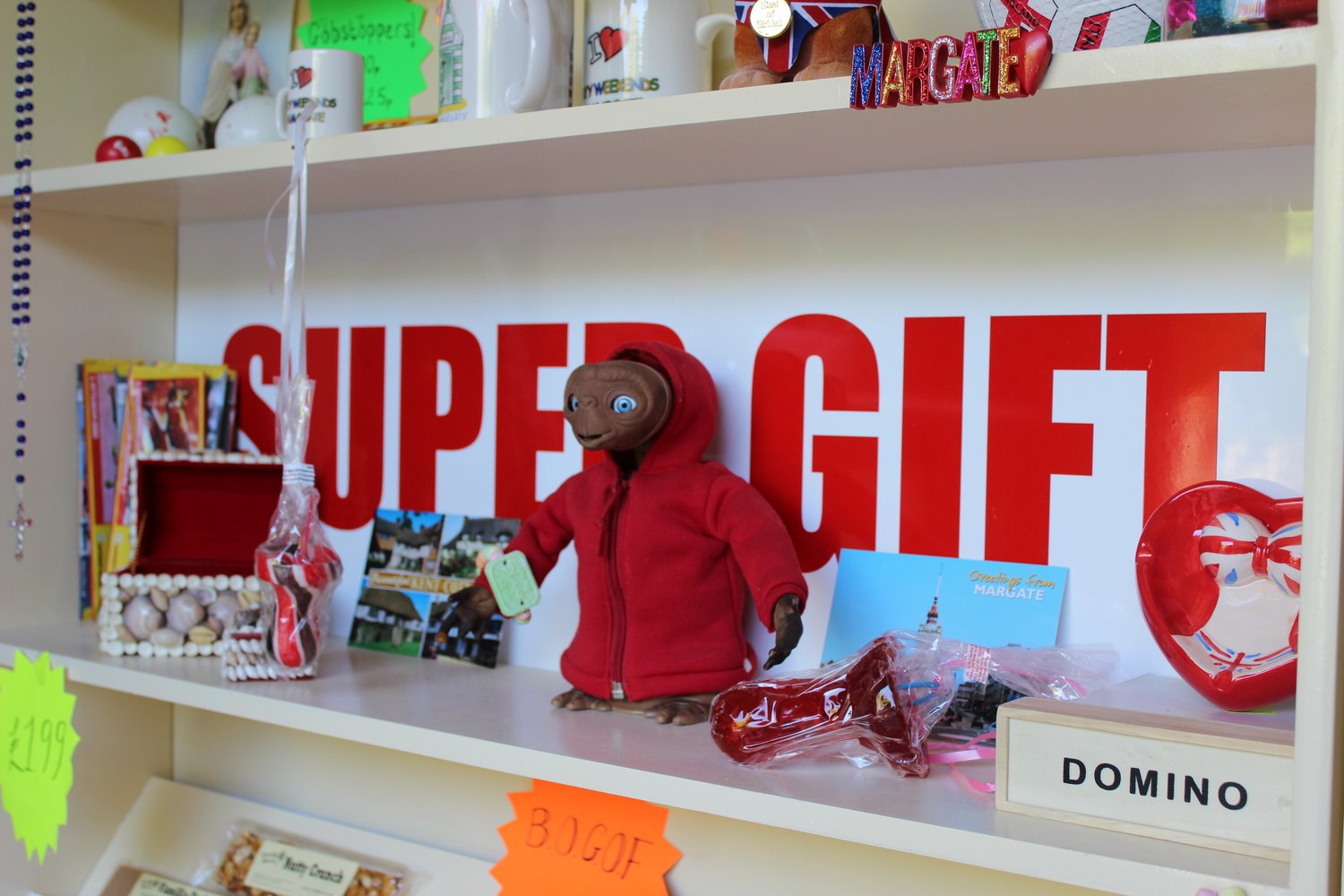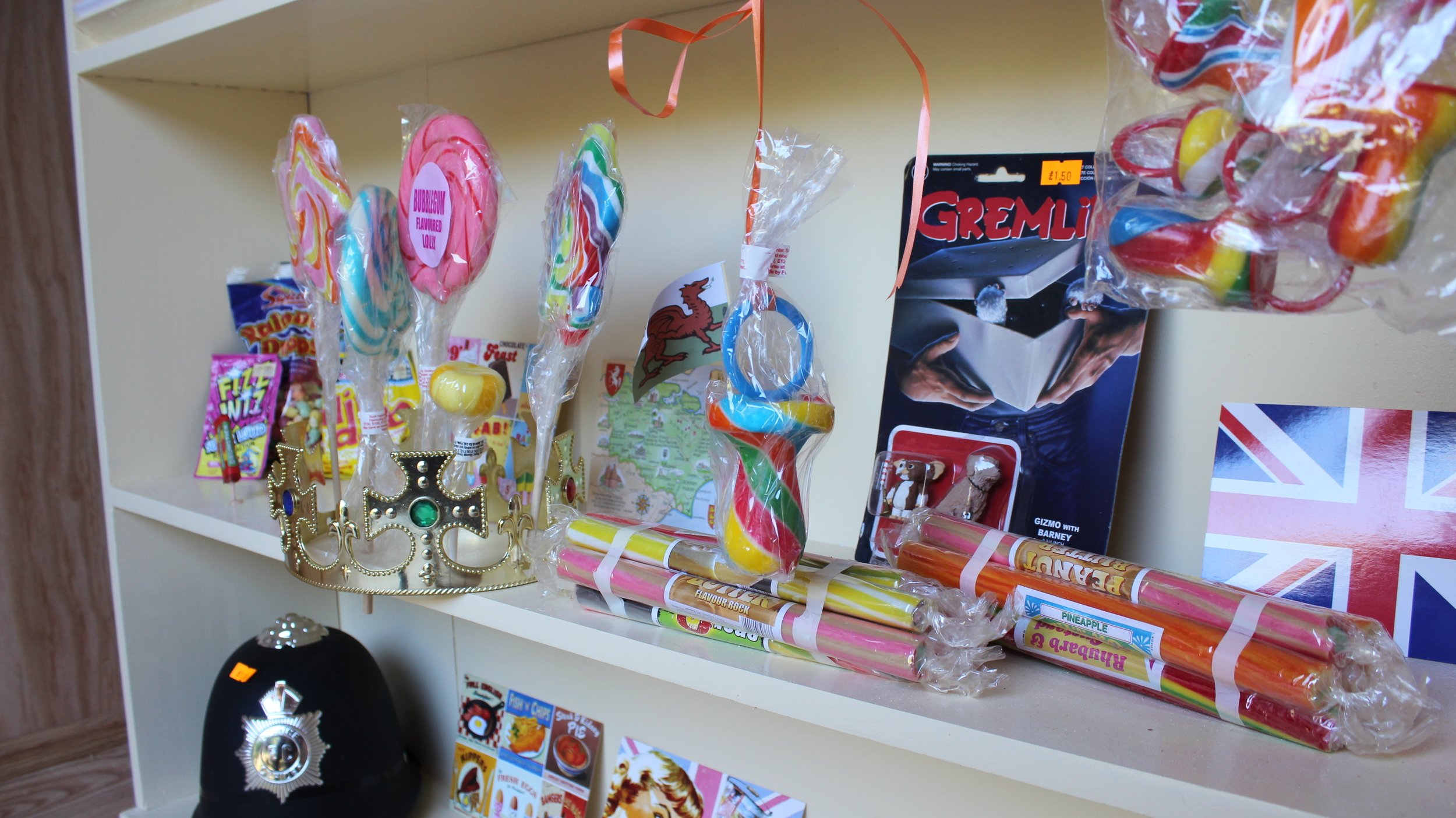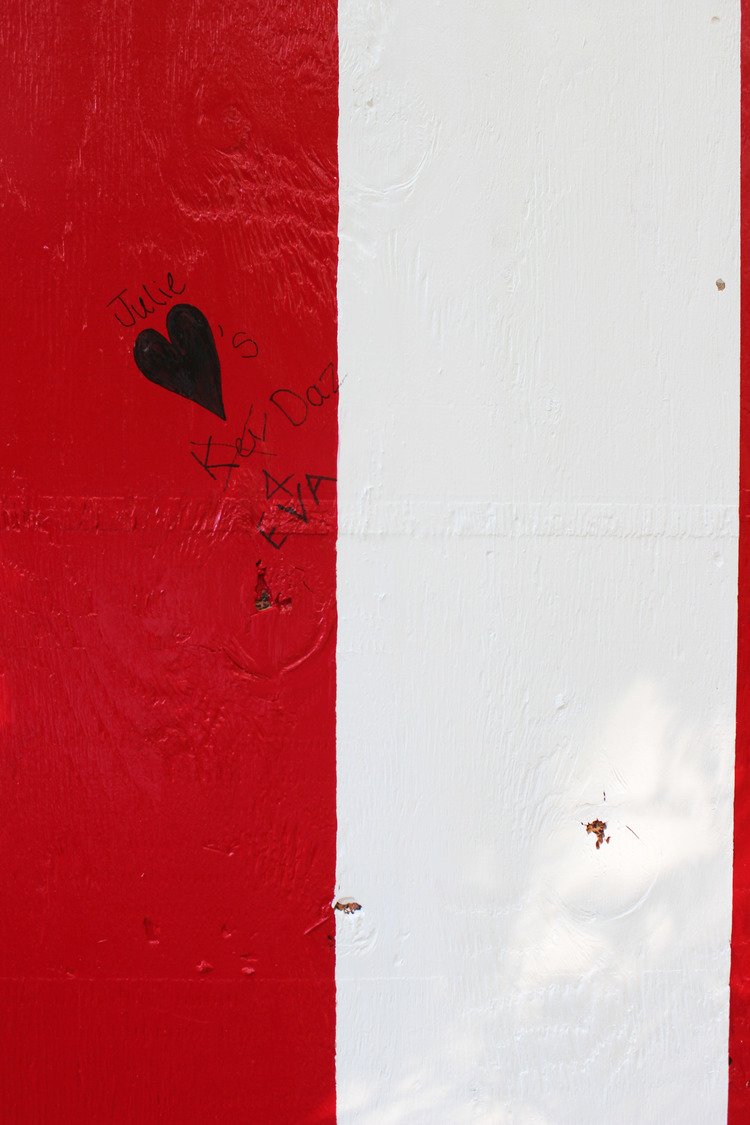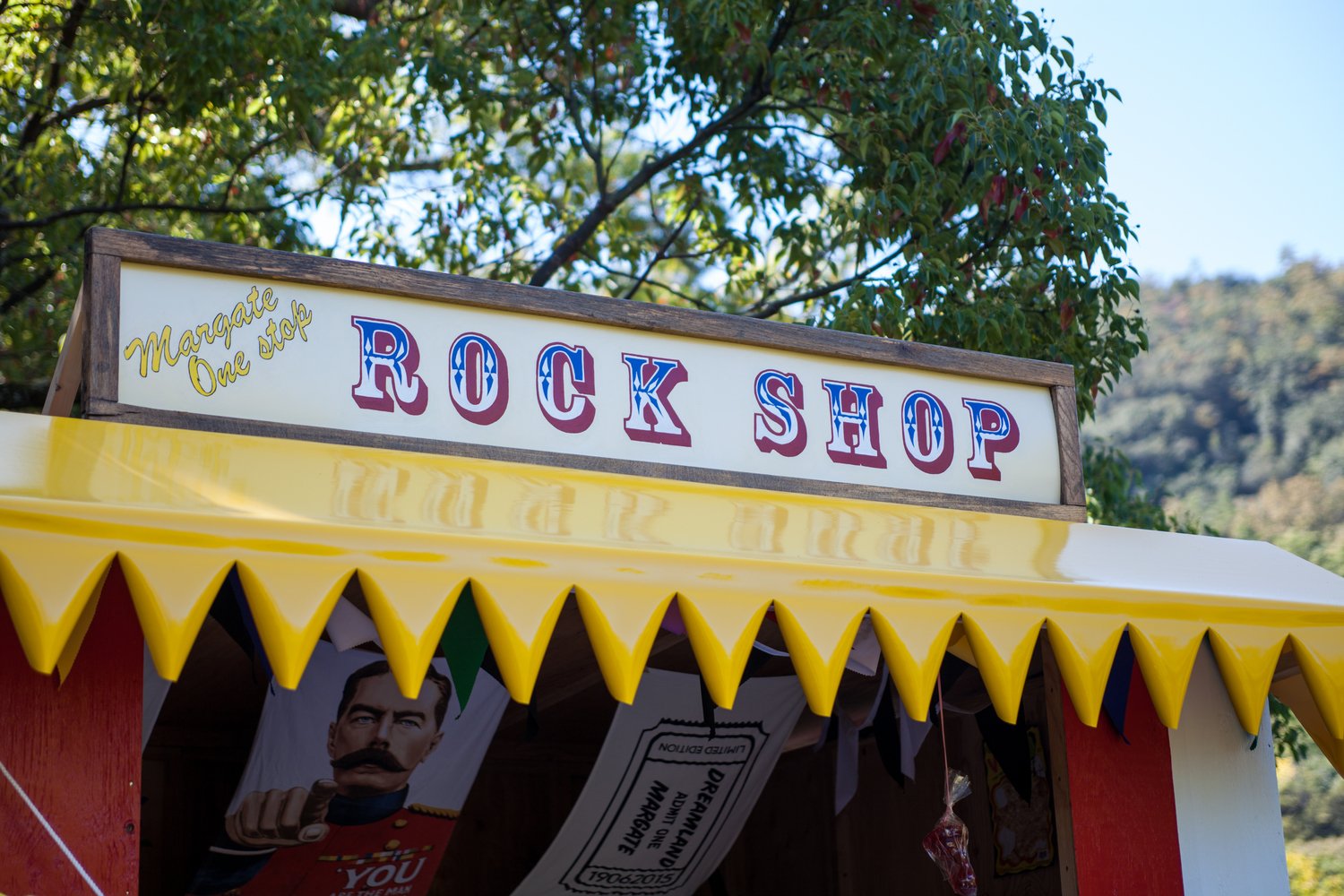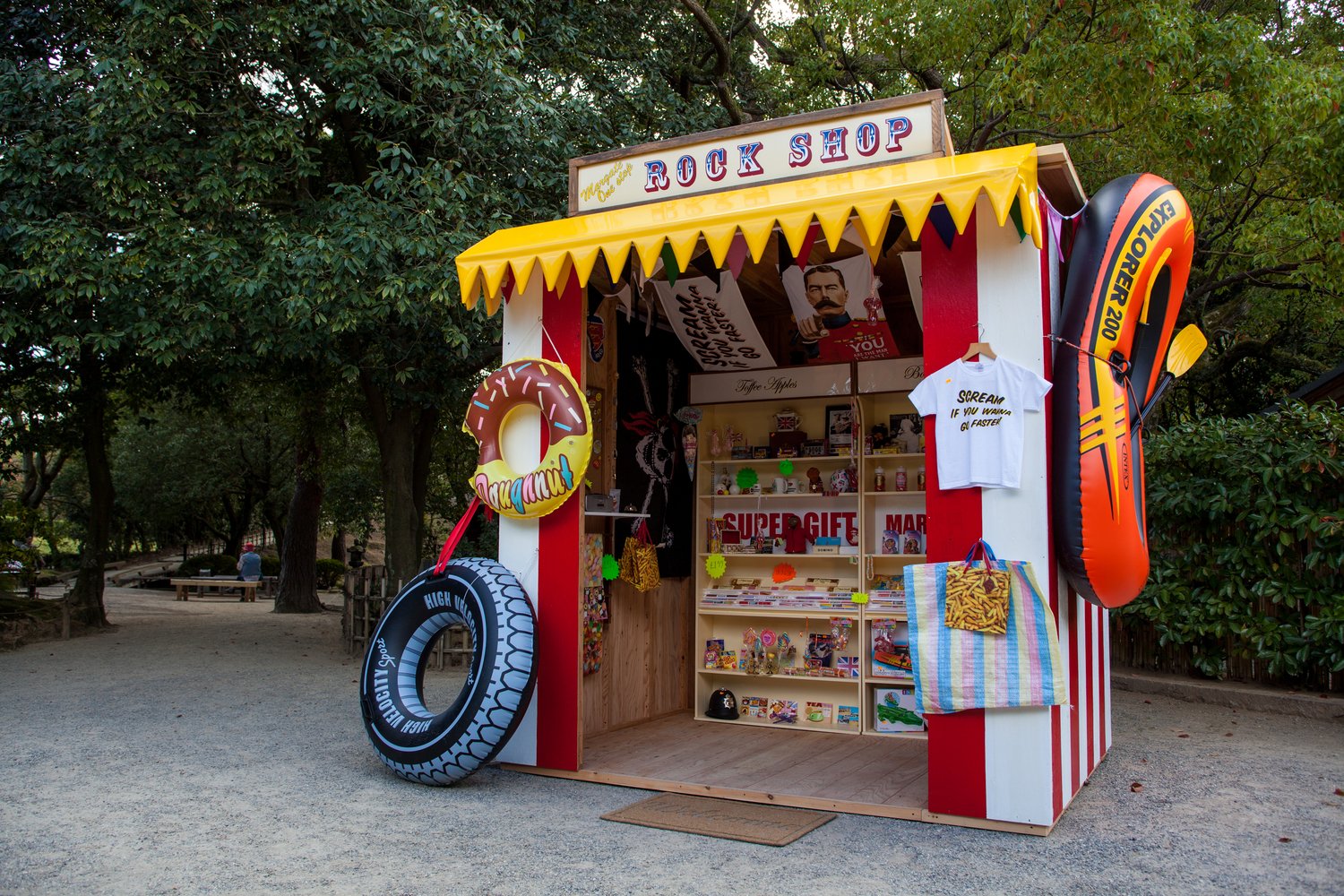

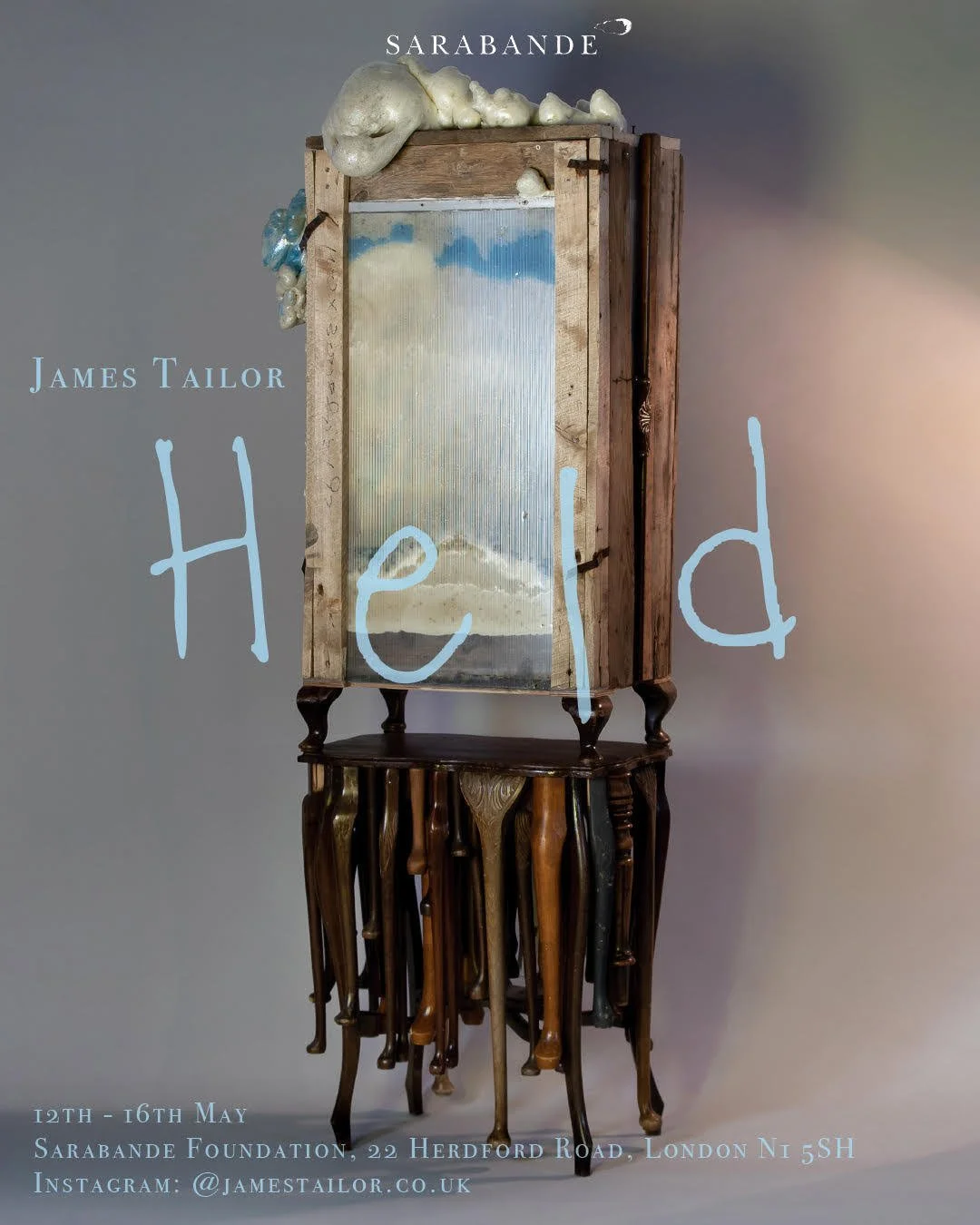
Held - James Tailor
For his first solo exhibition in London at the Sarabande Foundation and in advocacy of Mental Health Awareness Week, artist James Tailor presents paintings and sculptures that communicate feelings of frustration and anxiety – of being almost too overwhelmed to continue. Equally, his works evoke a sense of eventual resolution, where obstructions have been removed through the sheer determination of continuing to put one foot in front of the other. His work encapsulates issues of entrapment, self-doubt, hopelessness, mortality but also tenacity and strength of purpose.
Throughout his practice, Tailor’s paintings and assemblage sculptures are created out of an acute sense of physical materiality that provides an effective hinge between material fact and emotion. His modernist abstract paintings explore the limitations of paint and are realised through a labour-intensive process that Tailor has perfected over 10 years – employing techniques of a self-made paint skins, impasto or coagulation techniques. The resulting paintings emerge through attention to boundaries and surface, and convey principles of abjection.
His sculptures bring together disparate domestic objects such as tables or legs that have been abandoned or no longer fit for purpose and are then assembled together – reconfigured and repurposed – so that they convey brokenness at a point of collapse. Yet, as assemblages, they invite a sense of hope or potential through their transformation as objects now held together.
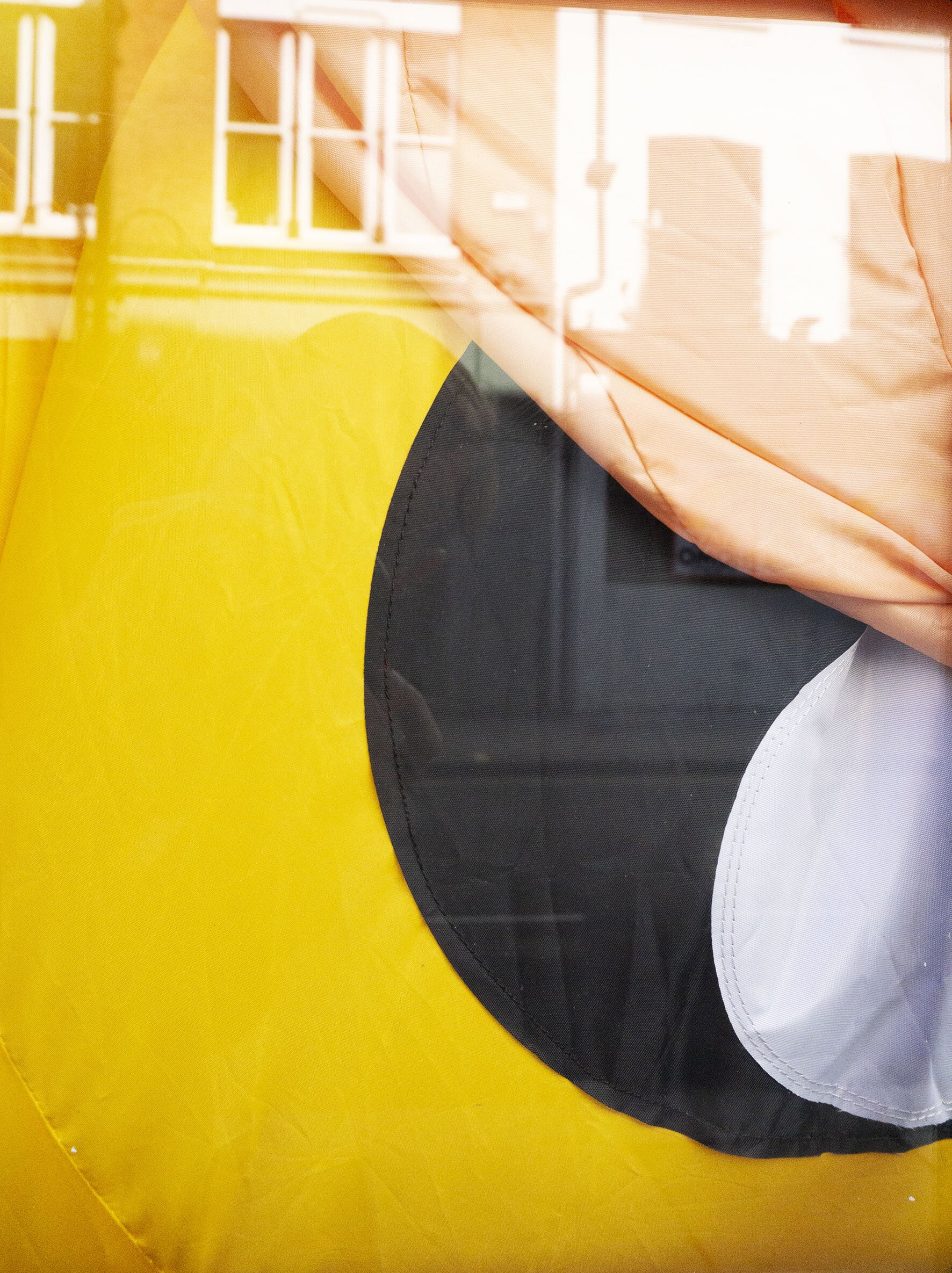
CAPACITY
PRESS RELEASE
The Smallest Gallery in Soho presents
Title: Capacity
Medium: Inflatable, Lights and found objects
Size: 287 x 264 x 207cm
Year: 2020
24th June - 31st August 2020
Location: 62 Dean Street, Soho, London, W1D 4QF
The Smallest Gallery in Soho is delighted to present a new installation by London based artist James Tailor. Under unique circumstances where the galley’s art is only to be viewed from the street, it is a cultural location showing art where people can visit & at the same time keep their social distance.
A global commentary on Covid-19, the installation incorporates attributes of outbreak, anxiety, restriction of movement, and isolation, and highlights the strains and dangers faced by NHS and key-workers, emergency services, delivery and supermarket workers, businesses, the self-employed and the claustrophobia the general public feel being asked to stay at home.
In this instance, a pre-existing loaned inflatable from Megaflatables of a Teddy Bear - often seen as a symbol of innocence and comfort - has been installed, which references the global Teddy Bear Hunt, against Pantone 300 background, the signature colour of the NHS, acting as a symbol of hope.
At full capacity the inflatable is twice the size of the interior, creating a visual illusion as the work expands to what seems like a bursting point and then deflates - an oversized visual representation of the anxious breath - holding and hopeful anticipation that we have been experiencing as a society.
Inflating & deflating within each hour, the motion magnifies the restrictive nature of the space while keeping viewers engaged.
We are all human & must stand with one another. Today, tomorrow & forever. TSGIS & James Tailor stand in solidarity & support with Black communities across the world. We as humanity have an individual & collective duty to do better.
About The Smallest Gallery in Soho
The Smallest Gallery in Soho is a historic shop-front which faces onto Dean Street, in the heart of Soho. The aim of this intimate gallery is to display artwork that captures people’s attention on their journey through Soho and encourage them to stop, think and be inspired. It hopes to transcend the rapid changes of building developments and the dispersion of the creative cohort - that was once so vibrant within the area - by exhibiting free and engaging art works to view from the street. The Gallery is run and curated by Philip Levine and Andreia Costa with support from The Garage Soho.
About the Artist:
James Tailor is an artist based in London, after finishing his MA at Central St Martins in 2018 he was awarded the Helen Scott Lidgett, Acme Studio award. During his time studying at CSM he interned with the Chapman Brothers as well as being chosen to go to Japan and create site specific art in response to Ritsurin Gardens. He has worked on large high profile events and collaborated with some of the most prolific artists and photographers. Tailor includes Adidas, Nick Knight, Kanye West, Sir Elton John, Kate Moss, Naomi Campbell, The Chapman Brothers, Kylie Minogue, and Boy George as collaborators, patrons or collectors of his work. From 2018 to 2019 Tailor worked as an assistant with Phyllida Barlow while maintaining his own practice. He has shown in London as-well as working with galleries around the world, previously featured in the Catlin Guide 2015, Extreme Typography Of The Garden and ArtMaze magazine among others, he has forthcoming interviews with The Asian Curator and the Delphian Gallery. At the same time as making work for The Public Gallery, Tailor has also been planning shows with ASC gallery - London.
Website: www.jamestailor.co.uk
Instagram: @jamestailor
About the Managers/Curators:
Philip Levine
Philip has been working in the creative, cultural industries for the last decade as a producer. This has ranged from exhibitions, events, publishing, talks and creating his own unique artwork under the title ‘Headism’. He has gained a MA in Culture, Policy and Management at City, University of London and now works in charity. Being from London, his passion is knowing ‘who and what’ is up and coming in cultural trends and being involved within them.
Andreia Costa
Andreia is an Associate Architect at Jamie Fobert Architects. She studied in the Faculty of Architecture at the University of Porto and practiced for 3 years in her native Portugal. Before moving to the UK, Andreia decided to explore her contemporary art interest by working in Serralves Museum of Contemporary Art as an architecture and art lecturer. In 2010 she joined Jamie Fobert Architects, where she has been involved in several projects including Selfridges and Tate exhibitions.
Other support from:
Lighting design: Syntax Lighting
Lighting: Architectural FX
https://www.megainflatables.com/inflatable-art/
The Smallest Gallery in Soho has displays rotating every two or three months.
‘Capacity’ will be on from between June - August 2020
For more information about The Smallest Gallery in Soho:
Contact: gallery@thegaragesoho.london
Sales: gallery@thegaragesoho.london
Instagram: @thesmallestgalleryinsoho
Twitter: @smallgallsoho
More Images below

NO TIME LIKE THE PRESENT
NO TIME LIKE THE PRESENT will be launching on 6th May 2020
PUBLIC Gallery presents NO TIME LIKE THE PRESENT, a digital exhibition aiming to help stimulate connection and engagement during this unprecedented period of physical isolation being experienced worldwide. Spanning a wide range of media – including drawing, painting, textile, photography, video and sculpture – this group exhibition brings together over 50 artists from around the world, all of which have been invited to create one physical work and one video in response to the current reality. The environment in which art is being made has changed. For the time being, many artists are without access to their studios, regular materials and like everybody else the ability to continue with their ‘everyday lives’. Yet artists adapt; now working in new spaces, using things at hand and with a newfound opportunity to experiment as all physical commitments are on hold. When the world emerges from this state of limbo it will no doubt be different. In these new works artists question the modes of life which have contributed to the current state of affairs, explore their own personal stories before, during and after isolation, contemplate the defining challenges for cultures re-emerging from quarantine, and imagine new ways of living. The videos created act in some instances as independent works, in others as extensions of the physical works, as well as snippets of life under lockdown and the feelings that have come to fruition. While each creation is in some way an individual response all ultimately act as a symbol of our interconnected whole, the fact that no one is immune to the risk as there are underlying biological and chemical realities that bind us – a reflection that should stay with us long after the crisis passes. Presented as a standalone online experience, NO TIME LIKE THE PRESENT brings these new works and videos together to form a unique snapshot of how artists react and adapt to such changes; how they process and question this unparalleled situation from their individual and shared perspectives. As the artist and theorist Ian Alan Paul aptly states: ‘Now is a time for imagination, invention, and experimentation, leveraging each as a means of producing new kinds of knowledge about our situation and new modes of struggle within it.’

Bodies: Self and Sex
BODIES: SELF & SEX
22 November 2019 - 05 January 2020
Steve Caplin |Eric Ceccarini | Karim Hamid | Ellie Howitt | Camilla Hanney | Anish Kapoor | Lucy Neish | Lydia Pettit | Keith Roberts | James Tailor | Alison Watt | Traditional African Art
No 20 Arts is delighted to present BODIES: SELF & SEX, a group show featuring works by Steve Caplin, Eric Ceccarini, Karim Hamid, Ellie Howitt, Camilla Hanney, Anish Kapoor, Lucy Neish, Lydia Pettit, Keith Roberts, James Tailor and Alison Watt, as well as ethnic African pieces. The exhibition wishes to present different approaches to exploring the self and sexuality as carried out by nine different artists. The contemporary perspective is complemented by various examples of traditional African artworks which reinforces the historic and ever-evolving interest of human beings in the perception of ourselves and our sexuality.

On Painting
On Painting
No. 20 Arts
20 Cross Street, Islington.
London N1 2BG
14th June - 28th July 2019


Five Years: Two Cakes (Duo Show)
TWO CAKES Kristaps Ancāns / James Tailor 24 November - 2 December 2018 Open: Sat-Sun 1-6pm Preview: Friday 23 November 6-9pm
Five Years presents new work by Kristaps Ancāns and James Tailor. Both artists work at the intersection of painting, sculpture and installation: combining laborious and painstaking material processes with found objects and functionless machinery, their enigmatic assemblages invoke a forlorn beauty. Kristaps Ancāns’s practice is modelled on scientific enquiry, following a methodology in which experimental analysis of the properties and functional limits of materials and systems form the bases of absurdist conceptual games. His sculptures and installations often contain a kinetic component - repetitious movements explore relationships between static/passive and kinetic/active components. The deployment of language is equally integral to his approach. If mechanics and newly invented materials are the immediately tangible components of his work, text is the primary vehicle for its cerebral dimension, where logic is disrupted and nonsensical statements carry a certain level of inner pathos. His works pose themselves as questions rather than statements, unsure of their own status, calling into doubt their relationship with the viewer. They maintain a precariously balanced point where formal values, physical laws and allusive references are all set in play – on the brink of undermining each other but all the while holding together in a disconcerting harmony.
James Tailor uses mundane and discarded objects and materials alongside meticulous manual production processes to produce a form of material allegory - assemblages that articulate deeply personal reflections on experience and the world. The objects he uses convey an inherent sadness and a sense of anticipation: it is precisely this feeling that attracts him, because of a connection with his own life experiences. These objects are then paired with acrylic paint, which he obsessively reworks into malleable skeins of densely coloured, monochrome self-made material. Through draping, sculpting, casting or pleating the paint he reacts to the tensions inherent in the materials, which mirror the foldings of his own personal traumas. When manipulating the form, he considers colour, balance, composition and the matt or gloss quality of the surface, making it possible to direct it toward suggestions of the body, skin, entrapment, escape, fetish, intercourse, illness and mortality, all of which have a potential to be present in any given work.
Ancāns and Tailor are both recent graduates from the MA Fine Art course at Central Saint Martins. They were recipients of the Helen Scott Lidgett award in 2016 and 2017 respectively and participants in the Acme Graduate Programme.
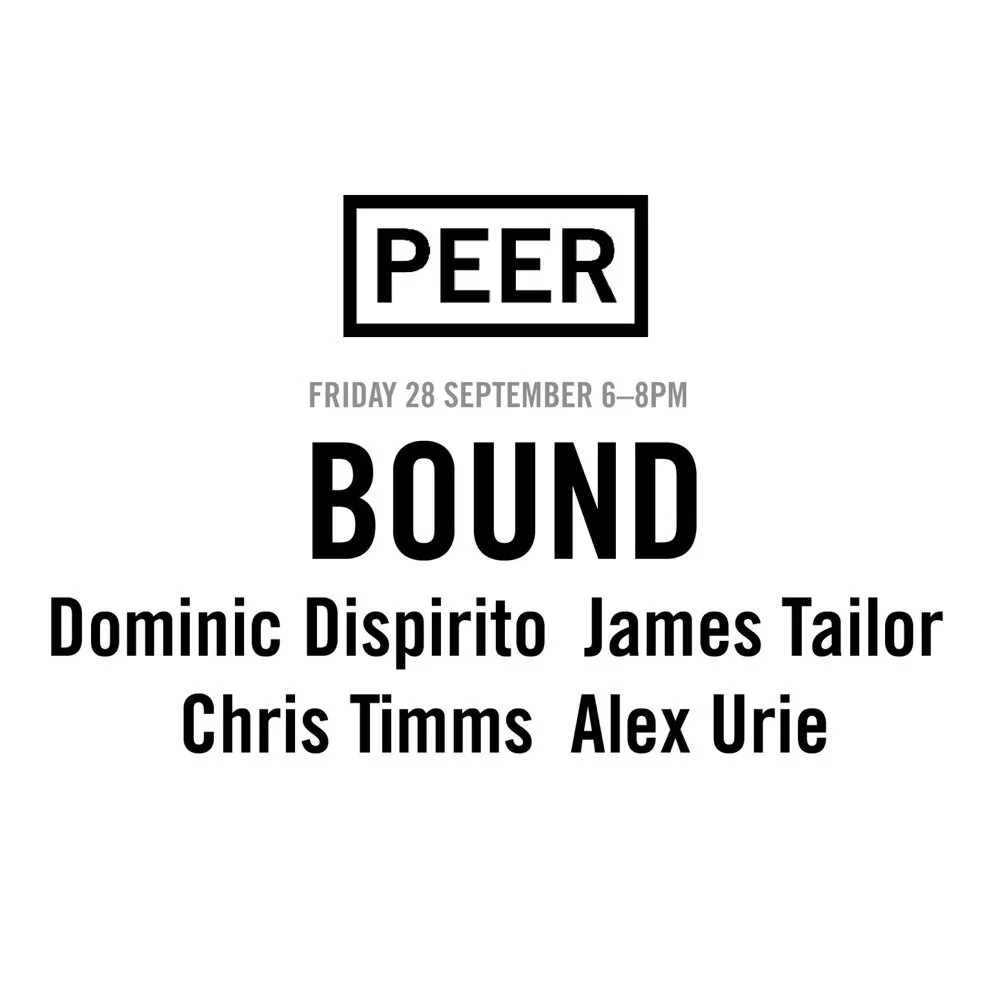
Last show at Peer Gallery: Bound
BOUND presents the work of four artists who became MA graduates in 2017 from four London-based art colleges, and who have all just completed a year-long studio residency at Acme’s Warton House studios in Stratford. This exhibition also marks PEER’s third year of partnership with Acme, offering young artists the chance to exhibit at an acclaimed gallery and benefit from the opportunity to work with its small professional team. This year’s graduates include work by three artists for whom painting forms a central part of their practice and an artist who works across performance and sound.
Dominic Dispirito’s (Adrian Carruthers Award, UCL Slade) painting, sculpture and animation has its roots in digital technology such as iPhone apps. Resolutely and boldly figurative, the people and places that appear in Dispirito’s work have often referenced the artist’s working class heritage and more recently have looked at images from art history. Working on a variety of scales, Dispirito’s work is usually characterised by the simple and
direct rendering of his imagery. The work shown at PEER has all been produced in the last few weeks, and Dispirito has described them as “dealing with anxieties around surviving in the world in which we live.”
Alex Urie’s (MA Studio Award, Chelsea College of Art) paintings deal with residual spaces, bringing together elements taken from cartoon landscapes and film stills, along with observed details encountered in everyday life. The work is process driven; recognisable forms are undermined by the use of staining and timed action. The fittings and furniture of these paintings become dislodged and corrupted within an intentionally unstable ground. Trace, itinerant figures begin to emerge, almost as a by-product, and are transposed from one canvas to the next, leading off down narrative detours.
James Tailor (Helen Scott Lidgett Award, Central Saint Martins) makes work that resides in an intersection between painting and sculpture. He uses found materials, often repurposing furniture or domestic objects. A key process of his practice is to painstakingly produce a kind of malleable skin that the artist creates from laying acrylic paint onto glass in expansive layer after layer and leaving to dry until it can be easily manipulated into luscious folds or pleats onto stretchers or as part of his assemblages. Recently he has been working predominantly with the colour pink, and for PEER has produced his most ambitious sculptural painting which will measure more than five metres in length.
Chris Timms (MFA Award, Goldsmiths) works with performance and sound and is currently exploring stuttering and disfluency as forms of estrangement, interruption, and multiplicity through embodied speech. His work has been informed by an ongoing exploration and collection of output produced by figures who have spoken with a disfluency or stutter. Originating from the sequence, a liturgical musical form that was codified and inscribed by a stuttering monk, Sequence III continues an ongoing series of variations exploring abstractions and mutations of the voice and speech. Timms has also organised a performative listening event ‘Stucco echoes mouth, a trembling of the frame’ on 18 October.
Acme provides nearly 600 affordable studio spaces to artists across London. Focusing on the transition between college and professional practice, Acme aims to intervene in critical points in an artist’s career. As part of Acme’s Residencies & Awards Programme, the Acme Graduate Programme provides recent graduates with a rent-free shared studio for one year, cash bursary, mentoring from visiting artists and curators, and the opportunity to work towards a public project or exhibition. The programme offers emerging artists the time, space, financial support and opportunities to build their practice beyond art school within a supportive network/shared community of peers. In 2016-17, the graduates received group mentoring and support from Chris Fite Wassilak, Jonathan Baldock and others. The programme is generously supported by Patrick Lynch, Jane Hamlyn and the families of Adrian Carruthers and Helen Scott Lidgett.


THE COB GALLERY: FORM
Katja Angeli | Cristina BanBan | Dominic Beattie | Asger Carlsen | Vanessa da Silva | Realf Heygate | Joseph Goody | Sif Norskov | Laurence Owen | Tristan Pigott | Paloma Proudfoot | George Rouy | Will Spratley | James Tailor
Cob Gallery is pleased to present FORM, the debut exhibition in a three-part series to run over the course of 2018.
NEW WORK: FORM, SUBJECT, MATERIAL aims to exhibit selected groups of young, international multidisciplinary artists who bring distinct voices and striking approaches to these three fields of enquiry.
FORM is presented as a meeting of painting, sculpture, digital art, photography and mixed media works, examined through a dialogue between formal geometric structures and organic compositions. Explored throughout the exhibit is how these individual artists translate their subject matter and surroundings into the elemental, symmetrical or biomorphic. The exhibiting artists can be compared and contrasted through their differing contemporary engagements to form, not only through fabrication and rendering, but for their individual application of their unique artistic visual languages.
The three-part series format is inspired by a programme devised at Green Gallery, New York. Between 1960 and 1965, curator Richard Bellamy chose to exhibit the work of emerging artists who were redefining what art was, taking it into new directions, and using materials and forms in innovative ways.
…
Despite significant differences in practice and process, the works of Vanessa Da Silva, Katja Angeli, George Rouy, Asger Carlsen and Cristina BanBan all consider the human form as subject, whether it be through a more conceptual investigation or an overtly literal representation of the body. In part, Da Silva's sculptures, and Angeli’s assemblages both examine and translate the human form in movement and specifically dance. The shape and form of these works are suggestive of the body in motion rather than explicit in the representation of the body itself. This is distinct from Rouy and BanBan, who subvert and modify natural human appearances. Their aesthetics forge a lineage to tropes reminiscent of early modernist movements, choosing to exaggerate the human form by means of heightening characterisations. Similarly, the other worldliness appearance and deliberate distortion in form and pose of their subjects can be exchanged for metaphor or allegory.
Sif Norskov and Laurence Owen look to literature, including Folklore, early Mythology and Magical Realism as the foundations of their respective visual languages. Near recognisable objects and plant life are interchanged for the human figure throughout their compositions. Ambiguous in their placement, these shapes toy with what we perceive as the real and the imagined through planes of colour and forms that shift between representation and abstraction.
Pattern and abstraction are explored in the works of Dominic Beattie, Joseph Goody and Will Spratley. In particular, Goody and Spratley’s works are comparable in their embrace of geometry and formal shape, yet polarising in artistic intention. Goody’s methodical, process lead compositions question how materiality of paint can create a space that forgoes regularity and still resonates with emotional, and even figurative ideas. Goody’s gestural abstraction becomes a vehicle for expression, where Spratley’s sculptures urge us to consider the minimalist potential in everyday objects and surroundings. Spratley’s wall-mounted constructions are, in fact, direct abstract conversions of items found in his bedroom, including renditions of a football shirt and a David Hockney art exhibition poster. In this display, a tension is cultivated between organic manual means of representation and the appearance of something machine-like or systematic. Meanwhile, Beattie’s large scale abstract paintings concern the development of unique patterns and tie together the systems employed by both Goody and Spratley. Here, we see a lineage to tribal iconography, with geometric form applied to create an intense visual experience through the use of bold block colour and rhythmic outlines.
For Tristan Pigott, James Tailor and Realf Heygate, traditional painting resides at the heart of their practices. For all three artists, painting is the threshold to broader concepts, and all choose to push its limitations through their application of sculptural and digital accompaniments or counterparts. These expanded practices are direct challenges to notions of the artist hand, authenticity, perception and the medium itself. Tailor’s large-scale freestanding work is formed from sheets of a material made from paint, encased in a dissembled easel, confronting the distinctions between painting and sculpture. Similarly, Pigott and Heygate subvert traditions of painting through the canon of still life and trompe l’oeil aesthetics. Heygate converts his highly detailed paintings of archaeological artefacts into digital 3D objects as a means to explore the conversion of two-dimensional images into virtual spaces, a challenge to archival lineage in a digital age. Pigott's unique brand of high realism figurative painting has recently evolved into sculpture. In its veristic details, 'Slipped Wink’ toys with our immediate perception, but also bolsters Pigott’s continued exploration of how human ego is translated into the inanimate object, such as a chair.
This approach to humanising the inanimate can also be viewed in context with Paloma Proudfoot's sculptures, that are often realisations of borrowed shapes reminiscent of typically manufactured objects such as the bowling pin. Her interferences provide the ceramic interpretations with a human-like tactility that borders on the uncanny and surreal. Furthermore, Asger Carlsen’s photography utilises in-camera and post-processing techniques to interfere with the original image, creating unsettling images that sit uncomfortably within his candid, seemingly truthful world. Treating the digital image as raw material, his work erases the limitations of traditional photography and blurs the lines between photography, drawing, and sculpture. Carlsen’s ‘Hester’ series was created by photographing nude models in his studio, then setting to work at the computer, methodically erasing and reconfiguring any semblance of human anatomy. The works are rendered as digital sculptures of otherworldly flesh and bone, and exist in large black and white prints. As an extension to this series, Cob Gallery is pleased to exhibit one of his ‘Black Digital’ works, which resembles a material mass; similar to a lump of clay, but on closer inspection is a composite of barely recognisable human forms.


In Favour of Three Dimensions MLF | MARIE-LAURE FLEISCH
Press Release
For the exhibition In Favour of Three Dimensions, MLF | Marie-Laure Fleisch has invited four artists whose art can be characterized by an innovative approach to the materials and techniques they use to create their work: Jason Gringler, Manor Grunewald, Holly Hendry and James Tailor.
It is becoming increasingly evident that contemporary artists are not comfortable with the traditional vernacular linked to the act of “painting”. In order to continue to overcome the charged history of wall-hung artworks, there is a desire to push the medium into new realms by rethinking the materials previously considered as essential to the physical composition of paintings: the canvas, the stretcher and paint itself. Looking towards the future of painting rather than repeating past strategies of creation, artists are stretching the physical properties of these elements so far that they become unrecognizable, or even eliminating them entirely.
Using welded frames to contain layers of steel, plexiglass, epoxy and glass, Jason Gringler challenges our relationship with paintings, as the reflective quality of the pieces inevitably implicate the viewer and the surrounding architectural space in the refracted mirrored planes. Textures are created by cracks and ripples, the result of unmannered gestures made while integrating new materials and destroying unsuccessful elements of past works. These new lines attest to the acceptation of failure as well as the desire to create new form of mark making through the re-appropriation of past forms. He has recently developed a series of monochromes, purifying his past process to create minimal structures which attract the ambient light while maintaining a matte surface.
Exposing the ambiguity between digital technologies and analog techniques, Manor Grunewald is also occupied with the representation of the hand of the artist and the procedures which bring an artwork into being. Interested in the transitory states of artworks and the various forms they take during transport, storage or as archival material, Grunewald creates a vocabulary that incorporates shelving, construction materials and screen-like objects which obscure the original work or become the support for printed images. Evoking the hand of the artist without any apparent brushstrokes, Grunewald makes the viewer aware of the various physical processes engendered by the artist during the elaboration of the work through photocopied images.
Using a sculptural approach to painting, James Tailor has developed a technique of mixing acrylic medium with paint, creating sheet-like forms that can be used to envelope, drape, conceal, or expand existing objects. Commenting on the many artworks that are holed up in storage, James Tailor has created his own bubble wrap and tape, which he then uses to encase blank canvases. Taking found objects and re-appropriating their history to form new narratives, or creating new forms from blank canvases destined for traditional paintings, Tailor comments on complexities of human nature, such as identity, hopes, flaws and corruption.
Holly Hendry, a sculptor, superposes strata of plaster, marble, jesmonite, wood, and various objects to create works evoking geological processes, but also the human body and the internal processes of conversion. While the colour palette is often light-hearted and fresh, the forms and embedded teeth or bones remind us that we are all mortal beings made of flesh and bone. While she typically works with large three-dimensional forms, her wall mounted works offer another alternative to sculpture, creating sculptures which are dependent on the wall rather than on the floor to support their weight. These recently elaboured wall sculptures are comprised of multiple autonomous pieces which cannot exist without the physical support of the wall, allowing them to exist as one singular organism.

CSM MA Fine Art Exhibition: HELD MY HAND
Held My Hand
Installation capturing the moment of resolution before helping someone to cope with the inevitable.
In my degree show, Held My Hand, my methods of assemblage have remained the same buthe motivations behind this current body of work were very closely tied to the death of my father. It was not until I began to consider the curation of the works that I realised I was making a contemporary monument which captures the last moments of my dad’s life.
Much of my previous work has dealt with ideas that relate to the conversation between painting and sculpture, but since this experience I felt the need to create a body of works using emotion portrayed through objects and paint. This is the most personal work I have created to date.








